-
Content Count
15,131 -
Joined
-
Last visited
Never -
Feedback
N/A
Posts posted by Rss Bot
-
-
Do colours match shapes? According to Wassily Kandinsky, the two go hand in hand. The Russian painter, art theorist, and Bauhaus teacher put his theory to the test with an exercise for his students, which you can now complete online. Do your answers align with the ideas of the Bauhaus master?
If you're not familiar with Kandinsky, he was an authority on colour theory even before joining Bauhaus thanks to his book, On the Spiritual in Art. In it, he establishes distinct emotional and spiritual associations between specific colours and forms. To communicate the relationship between colour and shapes, he created an assignment for his students.
Now, thanks to an online exhibit created in created in partnership with digital innovation studio yU+co and the Getty Research Institute, you can take Kandinsky's test.
Named the Kandinsky Form and Color Exercise, this simple drag and drop quiz challenges you to match a primary colour with its corresponding shape, including a triangle, circle and square. Take the quiz right now by clicking here.

Artist Erich Mrozek made these colour studies based on Kandinsky’s ideas
Once you finish the quiz you'll be shown if you match Kandinsky's theory. You'll also find an explanation of why a certain colour can be matched to a particular shape.
"The results of Kandinsky's survey seemed to prove his argument," the results page explains, "as the majority of respondents answered according to his model".
The exercise is part of the interactive online exhibition Bauhaus: Building The New Artist, which celebrates 100 years of the famous school through various interactive activities.
"The desire of museums and cultural institutions to engage the public in new ways is the perfect opportunity to combine new technologies with our experience in storytelling in order to create something groundbreaking and enriching," says Garson Yu, founder and creative director of yU+co.
Want some of the Bauhaus aesthetic in your life? Check out our guide to the 10 objects that will bring Bauhaus style to your studio.
Related articles:
-
If you're looking for the best iPad Pro deals right now, you've come to the right place. These popular devices offer slick looks, powerful performance, and portability, but they don't come cheap. However, there are bargains to be had if you know where to look.
The article brings you the very best iPad Pro deals. Our dedicated tool automatically searches for the best prices from the most reputable retailers, so you can be confident you're not missing a bargain (including the best Prime Day deals offers from Amazon on 18 and 19 July).
Apple's tablets are now available in a range of sizes, models and colours, and are popular with creatives thanks to their winning balance of power and portability. Team them up with an Apple Pencil and one of the dedicated drawing apps for the iPad and you'd be hard pushed to find a more capable portable creative tool. There are also plenty of iPad accessories you can use to customise your device further.
In this guide, we've rounded up the best iPad Pro deals to be found online right now. Covering both the iPad Pro 11-inch and iPad Pro 12.9-inch models, these deals make the industry-leading Apple tablets more accessible than ever.
The best iPad Pro 11-inch (2018) deals
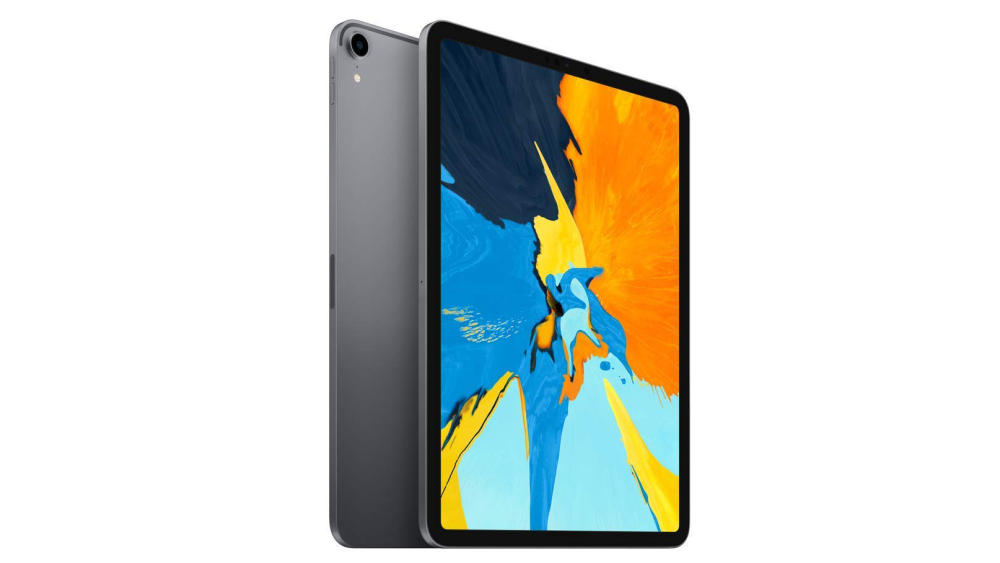
Don't miss out on this iPad Pro at a rock-bottom price
Offering the strength of a desktop machine in an ultra-thin package you can easily carry around with you, the iPad Pro 11-inch is designed to give users more creative freedom.
For more information, take a look at our iPad Pro 11" review, but headline features include Apple's specially developed A12X Bionic chip. This powerful engine delivers incredible speeds, especially when backed up by the machine's 6GB of RAM. Our heads were also turned by the screen's sharp 264-pixels per inch screen. Promising truer colour reproduction than competitors, the iPad 11-inch's display is perfect for artists.
Other stand out tools include variable pressure levels that bring out the best of the Apple Pencil. And considering that there are plenty of creative apps waiting to take advantage of what the Apple Pencil has to offer, most notably Pixelmator and Procreate, the iPad Pro 11-inch is sure to go down a storm with digital artists.
If you've been put off buying the iPad Pro-inch before now because of its cost, your patience has been rewarded. A limited time offer has seen the price of this powerful tablet come crashing down by over $100. So if this deal puts the device within your budget, make sure you order today so you don't miss out.
The best iPad Pro 12.9-inch (2018) deals

The iPad Pro 12.9 has a larger screen that's perfect for creators
It's not just the iPad Pro 11-inch we've managed to find at a lower price. Apple's biggest and best digital canvas, the iPad Pro 12.9-inch, can also be found for less if you know where to look. Take a look at our full iPad Pro 12.9" review.
Boasting a massive display and an incredible performance, this device is a favourite amongst digital artists thanks to its immersive screen. The recently released 2018 model is a huge upgrade on older models, however even iPad Pros from 2017 are incredible tools for creators.
Notable additions to the iPad Pro 12.9-inch 2018 include the Apple Pencil Gen 2, and a P3 colour gamut that will benefit illustrators and photo editors. There's good news for video editors too as its refresh rate has been upgraded to an adaptive 120Hz. This means that the device offers smooth frame rates that trump other models in the iPad range.
As you'd expect, a larger device demands a larger price. But if you're determined to get the best iPad Pro possible, this is the one you will want to start saving up for. And to make things a little easier, we've unearthed the lowest prices going for the 12.9-inch model. These cover unlocked devices and models from previous years, as well as the 2018 digital canvas.
We sort through thousands of deals to offer the best prices from the most trustworthy retailers. You can support us by clicking these independently selected links, as we may earn a commission on any purchase you make, at no extra cost to you.
Contact us if you have any questions or have found a better price.
Related articles:
-
The tech giant addressed a widely publicized Zoom bug with an automatic update mechanism usually reserved for removing malware.
-
Unless you're extremely fortunate or exceptionally gifted, if you want to make a name for yourself in design then you'll need to get the self-promotional bandwagon rolling. For some designers, it's a natural step on their path to global domination, while for other, less outgoing creatives, it can feel like a daunting task.
For some, merely having a stunning design portfolio and getting it seen by the right creative directors can be enough to set a fabulous career in motion. For everyone else, though, a bit more groundwork is going to be necessary, so here are eight killer tips to help you start getting noticed.
01. Remember you're the brand
If you've been in design for any amount of time then you'll have worked with a variety of brands, and you'll know all about the importance of brand guidelines. Well, now you're the brand, and you need to apply the same thinking to how you promote yourself. At the very least you'll need your own logo design; a strong, instantly recognisable colour palette is another good way to push your brand identity.
Also, though, you should think about your brand voice and what it says about your business. It never hurts to ramp up the positivity and enthusiasm when you're speaking as your brand rather than your everyday self; it might feel a little alien if you're naturally more reserved and self-deprecating in real life, but it works.
02. Work your social mojo

Social media is a must, but don't let it rule your life
Self-promotion these days can be a lot easier than it was when you had to mail out physical portfolios and do the rounds of agencies in person. A decent social media footprint is a must – check out our guide to nailing your social media strategy for plenty of helpful tips – and can help you get your work seen by the right people. Just don't fall into the trap of spending your entire day chasing likes and retweets; keep things focused.
03. Keep everything updated
The downside to having a heavy social media presence on top of your portfolio site is ensuring that everything's up to date. There are few things more off-putting than visiting a designer's portfolio and discovering that the last update was months or even years ago. So you need to ensure that once you have a new piece of work worth sharing, it gets shared in all the relevant places.
Remember, too, to include as much information as you can; it doesn't have to be a full case study, but at least try to answer the most salient questions that you think visitors might have about each project.
04. Find your audience
Helpful though it can be, social media is merely part of the self-promotion process. If you're serious about raising your profile and finding opportunities then you need to bite the bullet and contact some potential employers. This can be an arduous task, however you can make it considerably less so by being smart about your targeting.
Firing your portfolio at every agency you can think of isn't the best use of your time, but if you do your research and identify the firms whose work you love and where you believe your own work would be an excellent fit, and then contact the key people and make your case to them, you should get a much better hit rate than with a scattergun approach.
05. Meet in person

Nothing makes an impression like going out and meeting the people you want to work with
You can achieve a lot, self-promotion-wise, without even leaving your studio, but don't ever underestimate the potential of getting out there and meeting people. Whether it's turning up to your local networking events and pressing some flesh, or heading for the nearest city and visiting the agencies and studios you'd most love to work with, some face-to-face contact is your opportunity to make the sort of impression that you'll never quite carry off over email or social media.
06. Collaborate if you can
Collaboration is a two-way street. Obviously there are benefits for less established designers in collaborating with a better-known name, but for the senior partner in the project there's also the opportunity to produce some work that's out of their comfort zone and gains them a little street cred to go with their respectability. So if a collaboration with one of your design heroes is on your bucket list, go ahead and make your pitch – the worst that can happen is that they'll turn you down.
07. Grow your reputation

Share your accumulated wisdom with a cracking conference talk
Once your self-promotion efforts start to pay off, you can't afford to rest on your laurels. Now's your chance to build your reputation, whether it's by getting out there and delivering some conference talks, doing some pro-bono work for a good cause that you'd like to support, entering yourself for some relevant awards or pursuing your own individual design dream. If the opportunity comes up to promote yourself in a way that fits in with your personal brand – and it's not going to take up too much of your time and energy – then go for it.
08. Enjoy yourself – but do the work
Self-promotion can feel like a never-ending task, but if you figure out your game plan and devise an approach that works around the sort of promotional techniques that you love to see, there's also a lot of fun to be had in staking out your place in the design industry.
Just don't get so caught up with it that you let the important stuff slide. Keep on creating work that delights people and make sure that's your main focus; the self-promotional side is the means by which you can get people to see it, and to ensure that you get to produce much more of it.
Related articles:
-
Apple has disabled the Walkie Talkie app from its Apple Watch products after a vulnerability was discovered enabling bad actors to eavesdrop on iPhone conversations.
-
APIs are hugely valuable tools for developers. Big players like Google, Apple, Facebook and Mozilla are increasingly allowing developers to make use of their most innovative IP to plug in fantastic functionality into their projects. Here’s our guide to some of the most innovative APIs around right now.
We'll start with a few APIs you probably should know about – these come from mega companies such as Facebook and Apple (Google has so many APIs we've created a separate Google APIs list).
As with all things web, anything being done by a for-profit company leads to the arrival of at least five open-source alternatives. So further down the list you'll find eight more APIs ‘from the street’ – if you are lucky, your browser already has support for them out of the box.
For more plugins to try, take a look at our guides to the best JavaScript APIs and HTML APIs.
01. Facebook Graph API
Whether we like it or hate it – all roads lead to Facebook. The company has focused its once sprawling API ecosystem into the Graph API. The entity of the social space is perceived as a graph data structure, with which third-party applications can interact using traditional graph theory operations.
While the mathematical part of the problem is usually simple, keep in mind that the Graph API allows for incredibly destructive actions such as posting spam. Due to that, devs working on Graph-API-based programs need to be prepared for quite a bit of verification effort. Facebook requires complex authentication flows, which can become problematic especially when working in a pure JavaScript environment. Nevertheless, the API remains the only valid way to interact with Facebook.
02. Apple Pay on the Web
Payment processors and social networks are especially defined by Metcalfe’s law of network usability – the value of a network increases with the square of its number of users.
In light of this, while Apple Pay may not be quite as flexible a friend as MasterCard or Visa, it does unlock payments with the estimated 253 million people that use the service worldwide.
Should you feel like accepting Apple Pay on your website, implement the various JavaScript-based Apple Pay on the Web API interfaces but do keep in mind that the product remains limited to people owning recent iOS devices. Android and Windows users, obviously, will be left out unless they visit the website with an iPhone – one very important reason why you should not use Apple Pay as the only payment processor in your application.
03. MapKit JS
When Apple decided to ditch Google’s mapping application in favour of its own, pundits had a really good time laughing at the Cupertinians – indeed, the first revision of the product made laughable and extremely funny mistakes. Nevertheless, continued engineering investment has brought the product to a point where it is currently a more than viable mapping solution.
Apple, logically, wants to expand the reach of its product while staying off of competitors’ platforms. Due to that, the decision to take to the web was logical. One interesting aspect of MapKit JS is the extremely generous free allowance – you can run 250,000 views and 25,000 service calls per day through its API for free.
04. Stripe API
An old adage says that open-source developers need to eat too – in lieu of revenue, you’ll find that your landlord does not accept download figures. Fortunately, collecting money from customers is not as difficult as it used to be.
Stripe is a one-size-fits-all company – its SDK provides you with a set of widgets for credit card information input. The Stripe API is not limited to one-time transactions either: if you monetise your service via recurring purchases, a useful extension can collect your money.
While Stripe – obviously – cannot take money from PayPal, the company has an impressive range of partners. You can use both Apple and Google Pay along with the Chinese WeChat and AliExpress payment services. Furthermore, the fee structure of Stripe is simpler than that of its blue competitor – especially if you are worried about chargebacks or refunds. Stripe’s way of handling the problem leads to fewer surprises when the actual bill arrives.
05. Ambient Light Events
PDAs with colour displays introduced developers to problems related to screen brightness – crank it up and the battery will run out; too low and users get eyestrain trying to make out details drowned out by ambient light sources. Fortunately, advancing sensor technology made ambient light sensors affordable and today even cheap feature phones come with fully featured sensors, allowing developers to harness them to drive changes in their apps.
Mozilla’s Ambient Light API lets your website collect information from these sensors. Content can then adapt itself to the situation at hand – for example, an eye- and sleep-friendly night mode could auto-activate in the dark. The API is flexible enough to cover both polling and event-driven scenarios.
However, providing users with a manual override capability is well advised. Some users rising before dawn will help themselves to wake up by reading – forcing them to endure a sleep-inducing colour scheme against their will is a sure-fire way to reduce customer satisfaction.
06. Fullscreen API
While browsers do a good job of using screen real estate, hiding the address bar sometimes helps. In this case, the Fullscreen API is a convenient way to deal with the problem and enabling it requires but a few lines of code.
Once requestFullscreen is invoked, the browser is instructed to display the parent element in full-screen mode. This is especially useful when combined with an interactive tag such as an HTML5 <video> markup element.
However, as with other APIs, invoking the method and getting permission are a different kettle of fish – if the user does not agree to full-screen mode, most browsers will not let you hide the address bar.
07. Geolocation API
Getting access to a user’s location is paramount if many business processes are to work seamlessly. The Geolocation API lets you access position information provided by a device’s GPS receivers and other sensors, such as Wi-Fi.
Thanks to its importance for ecommerce, almost all browsers support the Geolocation API, enabling you to find out where the user is located via but a few lines of code. However, keep in mind that because the information returned is sensitive, the browser vendors require all kinds of additional security. For example, the browser will invariably display a permission dialog before providing coordinates, which is vital when it comes to ensuring you have a user’s informed consent.
08. HTML Drag and Drop API
The HTML Drag and Drop API does what exactly what it says on the tin: some HTML elements are marked as draggable, while others are marked as droppable. From that point onward, the user can drag and drop various elements to move them around in the browser, duplicate them, create links between them or even drag in files from outside of their browser.
Alongside obvious DOM events it exposes like drag and drop, it also offers dragover, which activates when the cursor is over a valid drop target, and dragend, which fires when a drag operation ends.
Sadly, nothing is without its shortcomings: for this API, the main problem comes when you’re working on mobile devices. While Drag and Drop worked well with the resistive streams of yore, few mobile browsers offer support on capacitive screens. Due to that, developers are well advised to provide an alternate way to access drag and drop induced functionality for mobile.
09. Intersection Observer API
Finding out if an element is visible isn’t easy, yet it is a very important job. Not only is this information interesting for advertisers but the data can also be used to implement various effects such as infinity scrolling or lazy loading.
The newly introduced Interaction Observer API helps address this. It expects the developer to provide two elements – one parent container and one child whose visibility is to be tracked. Developers then set up a threshold that determines how much of the element must be visible before the callback function is invoked.
This process might sound somewhat complex but works really well in practice. Furthermore, its browser support is exceptionally wide.
10. Push API
Pulling is a classic anti-pattern in the process computer space – sadly, web developers had little choice. The Push API provides a way around the problem. It is based on a traditional push system, where data is actively driven from the server side rather than by client-side requests.
In short, not only does this prevent users’ devices having to regularly issue pull requests to check whether new data is waiting for them but it also allows sites and apps to issue push notifications to mobiles and desktops.
Sadly, such features tend to invite abuse by unscrupulous developers. Due to that, almost all vendors tend to use a browser-based dialogue to get the user to agree to receiving notifications. Another important issue developers need to keep in mind involves quotas – most, if not all browsers limit the amount of messages that can be delivered at any given point in time.
11. Web Audio API
In bygone days, keeping a MIDI file playing in the background was a given. Some law firms in Austria went so far as to annoy their visitors with an orchestra’s worth of classical music.
The new Web Audio API, which currently is a W3C candidate, has nothing to do with this traditional source of nuisances. It, instead, provides a modern graph-based audio output API. This means that you set up a chain of filters, data sources and output sinks such as headphones or speakers. Once done, these are then fed with dynamically generated or locally stored content, resulting in a completely custom experience.
In theory, you could also use this API to simply play back MP3 or Ogg Vorbis files – a valid strategy but one that can be more efficiently delivered with the HTML5 <audio> element. The API can, instead, play out its strengths whenever you need to modify the output; the system provides a wide variety of nodes such as ConvolverNode and WaveShaperNode, which are used to add reverb and distortion to sound respectively.
Another area where the API excels is creating experiences that react to the music. If you’re working on a 2D or 3D project, you can feed variables from the Web Audio API into the canvas or WebGL APIs respectively, creating visualisations or games that react to factors like the audio’s frequency or volume.
12. WebVR API
While Microsoft’s introduction of the Kinect sensor was ill-fated, virtual-reality technologies are here to stay. Mozilla’s WebVR API – also supported by Microsoft Edge – lets your web apps and sites break the fourth wall.
Sadly, the API is just part of what’s needed for a complete VR scene. In particular, the API limits itself to providing a set of classes enumerating displays and position sensors connected to your user’s workstation or laptop. Actually getting something on-screen requires the use of additional APIs dedicated to the creation of three-dimensional scenes optimised for virtual reality.
One particularly useful candidate comes from the company behind the WebVR API – Mozilla’s A-Frame-API lets you create virtual reality scenes. Do, however, keep in mind that the development of such scenes is a completely different animal to the development work done on websites – yours truly’s painful experience shows that some developers will have a very hard time adapting their brain to the workflow required for the creation of three-dimensional objects.
This article was originally published in net, the world's best-selling magazine for web designers and developers. Subscribe here.
Read more:
-
Threatpost catches up with David Baker, the chief security officer at Bugcrowd, about the future of bug bounty programs.
-
German car manufacturer Volkswagen boasts one of the most world's most recognisable logos. And thanks to some recently shared vintage specifications, we can take a look at the fascinating precision that went into creating it.
With its straightforward, stripped back aesthetic, the Volkswagen logo perfectly reflects the ergonomic elegance that has come to define the brand's vehicles. It's a textbook example of our logo design advice in action.
On the face of it, the design might just appear to be the letters VW sitting in a circle. But the logo's composition is so deceptively harmonious that your brain appreciates that it works, perhaps without immediately knowing why.
Don't believe us? Just take a look at these vintage specifications for the logo, which have recently ignited an excited conversation on Reddit's r/Design channel.

It's simple, precise, and it works
As you can see, the angles and the spacing of the various design elements are all clearly labelled in relation to one another.
But what's really got people engaged is that these specifications pre-date vector files. Just imagine trying to create something so precise by hand, without the help of logo design tool such as Adobe Illustrator.
This explains why the specifications were so precise and clear, too. The plans for the VW logo ensure that it will look the same no matter the scale, which helps to keep the Volkswagen brand consistent. In a time before digital art tools were commonplace this consistency required more clarity to achieve, because you couldn't just sling over a vector file to a client or agency.
In the comments section in response to these plans, creators have taken a moment to marvel the old school approach to logo design. "This is fascinating, and really highlights the importance of drawing things with optical proportions instead of technical ones," says user SyntheticEverything.
This really highlights the importance of drawing things with optical proportions instead of technical ones
Meanwhile, user cream-of-cow explains when the landscape of logo design changed. "Up until the mid 1990s, many design schools were still this precise, this was for someone to reproduce or make the logo in 3D form."
"Nowadays, everything is computer perfect, I don't recall when's the last time I had to call out the size of something unless it was for if smaller/larger than X-dimensions, use this version of the logo," they add.
So have designers lost something with the rise of vector files? Not necessarily. But as this amusing tweet from Logo Geek points out, if you're going to rely on grids to help refine and perfect your mark, don't let them lead the design process. Otherwise you can end up with some pretty mangled results...
If these specifications have got you eager to start creating a logo of your very own, check out our guide to the best free logo design tools. Of course, you can always just pick up a pencil and a protractor and do it the VW way.
Related articles:
-
F-Secure Anti-Virus is an affordable antivirus solution that's easy to use (particularly in combination with other security tools) and has earned a place in our roundup of the best antivirus software.
F-Secure Anti-Virus is notable for its low price of $35.99 (about £28) for the one-computer, single year license. At first glance it looks to offer an exceptionally good deal, but going over the feature list, we realized how really basic this package is.
F-Secure Anti-Virus has no password manager, Wi-Fi protection, banking protection, file shredder, and no browsing protection. It's safe to say that it’s antivirus, and only antivirus.
Before we criticize it too much, we should point out that this same simplicity can be an advantage, especially for power users that plan to combine F-Secure with dedicated software to cover other needs, such as a URL filter, software firewall and other security software. However, more basic users, as well as those seeking the convenience of a single interface for multiple functions, the lack of features might be an issue.
Another downside is there are no multi-device discounts, extending beyond the three system, one-year license for $39.99 (about £31). Other antivirus solutions are more flexible; for those with multiple systems to protect, Bitdefender has flexible plans that cover one, three, five or up to 10 devices, for one, two or three years. This also is more affordable as well: a 10 PC, three-year Bitdefender license goes for only $162.50 (£125), which works out at a quite inexpensive $5.42 (£4.17) per device per year.
Setup
F-Secure offers a free 30-day trial of F-Secure Anti-Virus, but it's not easy to get. Before you can even download the installation file, you need to provide an email address and solve a CAPTCHA. You'll then receive a confirmation link via email, and after clicking on it, a web page opens to explain that still another email will arrive to provide both the license key and download link.
The next email arrived quickly, but lacked a license key (which we eventually realized was built into the executable name). Next, the software reported that the license was invalid, but that turned out to be an error, and then the installer proceeded to quickly do its thing without any further overtures. We are happy to report that the rest of the installation went without a hiccup, but that only left us wishing the rest of the process had been smoother.
Taking a look at the F-Secure program folder, we noted support files averaging 700MB in size. There was really nothing to be surprised about, but notably, F-Secure (as some others do) integrates the Bitdefender antivirus engine as well as its own. We have no problem with it, and even more so considering that the Bitdefender engine has a reputation for high accuracy, and it's reassuring to have dual antivirus engines.
Features
Nobody could accuse F-Secure Anti-Virus of overdoing it in the bonus feature department, as it has hardly any. It’s simply the basics, with antivirus scanning and the required security layers and settings.
The advantage of this approach is that F-Secure's interface is as simple as they come, and even a complete beginner will have no trouble with it.
The main console distills down to just two buttons: Virus Scan and Settings. Hit the first and F-Secure Anti-Virus performs a super quick scan (taking under a minute), deals with any suspected threats and displays an update on the system’s health. The other button, Settings, has just minimal configuration options.
Scanning
Power-users who prefer granular control will be disappointed by the lack of settings, because F-Secure offers few customizable options and always defaults to the quick scan, despite there being a full system scan buried deep in the settings menu.
F-Secure doesn't offer a removable drive scan, or any way to create a custom scan type. Competitors such as Avast and Avira cover these needs with options for manual scans and custom configuration settings, but F-Secure has a measly two checkboxes: 'Scan only known file types,' and 'Scan inside compressed files.'
However, F-Secure does offer one important extra tool: ransomware protection. For safety, it prevents untrusted applications from accessing files in designated folders. While this isn't a groundbreaking innovation (Windows 10's new 'controlled folder access' feature does pretty much the same thing), we appreciate the additional layer of protection.
At the end of the day, F-Secure excels at its core function, which is antivirus, notable for its quick speed, high accuracy and simplicity in use. It lacks in some other features, such as URL blocking, but these gaps can be filled with other, dedicated software. For users that are fine with multiple pieces of software, then F-Secure makes a fine choice for the antivirus part.
In our own malware tests, F-Secure Anti-Virus delivered a solid performance. To confirm this, we also examined results from leading antivirus testing labs for a comprehensive examination of the program’s strengths and weaknesses.
In AV Comparatives' monthly real-world protection tests, F-Secure performed admirably blocked 100% of test threats. Unfortunately the same testing revealed a high number of false positives, which lowers the total assigned score.
F-Secure ranked second place of the 18 solutions tested, but with 111 false positives. For comparison, Bitdefender (third place) had only two, and Kaspersky (fourth place) had just one.
AV-Test's August 2018 Windows Home User report showed even better results. F-Secure found and neutralized 100% of the test threats, with a lower number of false alarms. With 62 legitimate programs installed and activated, F-Secure blocked only a one, and gave an alarm about another. While not perfect, it was definitely quite liveable. For the rare situation when this does happen, users are given the choice to whitelist the blocked software, and then F-Secure will not banish it again.
Finally, we examined F-Secure’s impact on system performance. The PassMark Software November 2018 Security Products Performance Benchmark report gives an analysis looking at 15 of the top tier programs in the security area. F-Secure placed in the mid-range (eighth out of 14) suggesting that its impact on performance is perfectly average and acceptable. It's also worth noting that the testing was performed using the even higher tiered F-Secure Safe suite, and if anything F-Secure Anti-Virus is even more of a lightweight which will impact performance even less.
-
Hotspot Shield is a VPN platform developed by the US-based cybersecurity firm AnchorFree, which started out as a free sponsored Wi-Fi hotspot provider. Hotspot Shield is currently the VPN provider of choice for around 650 million people around the world, and is one of our picks for the best VPN in 2019.
Plans and pricing
Hotspot Shield has a rather generous money-back period. Specifically, if there is anything wrong with the service, you can ask for a refund within 45 days of signing up for a subscription
Hotspot Shield is available for free and as a paid version. The free version is supported by ads and limits the daily data transfer to 500MB. Free users also have a more limited choice of servers than the paid ones.
The paid account is available under three options. The first one is the one-month plan that costs $12.99 (about £10), followed by the 12-month option at $5.99 (about £5) per month, and finally, the 36-month subscription that will cost you only $2.99 (about £2.50) per month.
This VPN vendor also offers subscriptions for businesses with prices that start at $19.99 (about £16) per month.
Accepted methods of payment differ depending on your current location and include credit cards, PayPal, Alipay, Neosurf, Mint, gift cards, and more.
In case you want to test the service out before committing to any of the paid plans and the free version isn’t enough to do so fully, a seven-day free trial is offered. This trial is available if you sign up for any of the paid plans, except you aren’t charged during this period. If you want to avoid being charged, you need to cancel the subscription within seven days of signing up.
Features
Hotspot Shield offers its services on over 2,500 servers distributed across 25 countries around the globe. Virtual locations are available in 70 countries. The availability of the servers depends on the device used, with iOS users having access to the highest number.
One of its industry-standard features is a kill switch, a powerful safety mechanism put in place to protect your sensitive information from outside snoopers. It activates whenever your VPN connection drops, effectively blocking all internet access on your device. Although this tool isn’t available on mobile devices, Android users can make use of their device’s own integrated kill switch.
One Premium VPN account allows you to connect up to five devices at the same time. Unlike with other VPN providers, this number cannot be bypassed as Hotspot Shield doesn’t support installation on routers.
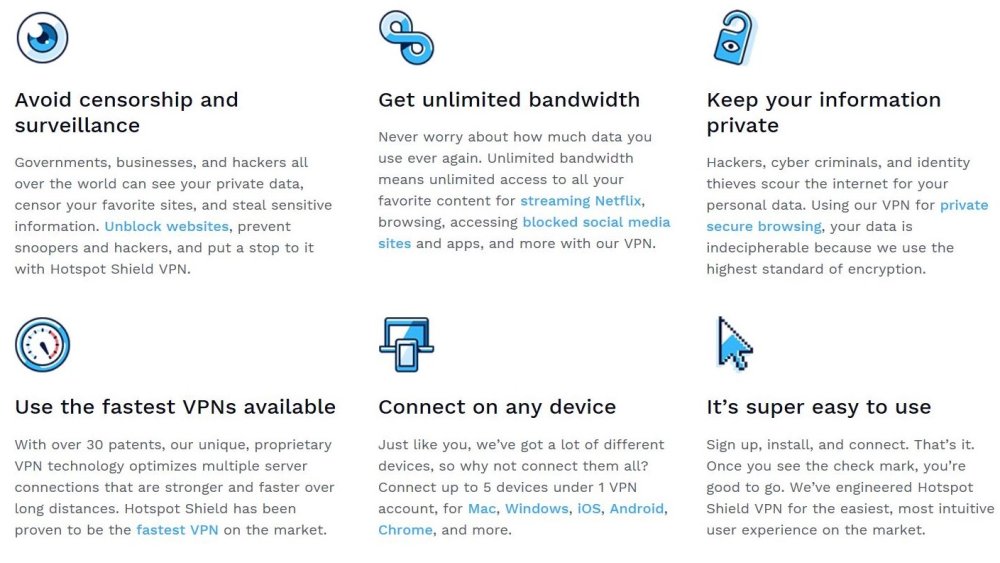
Image credit: Hotspot Shield
Privacy and logging
Hotspot Shield offers strong anonymity protection with the help of its proprietary Catapult Hydra technology. It uses this technology instead of commonplace protocols like OpenVPN, PPTP, etc because Hotspot Shield deems it safer and sturdier. This seems to be the shared view of other companies that employ Catapult Hydra for their own VPN provision, such as BitDefender and McAfee.
This technology is based on TLS 1.2 and utilizes different algorithms for the purposes of connection, authentication, client connections, and payload data exchange within the VPN tunnel. It uses an unusual combination of AES-128 and AES-256, along with the Elliptic Curve Diffie-Hellman (EDCHE) algorithm for Ephemeral Key Exchange. Ephemeral means that encryption keys are generated for every new user’s session and erased from memory when the session is over.
Hotspot Shield promises not to collect, store, or share information that can be used to identify you, including IP addresses. The company states it doesn’t retain any activity logs either. That said, these claims cannot be properly verified without an independent public audit, something that several other VPN providers have conducted.
Hotspot Shield is registered in the United States, a country with a somewhat poor reputation concerning the invasion of individuals’ privacy. This means that, if a government agency asks, Hotspot Shield will probably hand over any information demanded because it is subject to US laws.
On top of that, the provider has been accused of spying on its users for its own gain. Namely, the Washington DC-based Center for Democracy & Technology said in 2017 that Hotspot Shield had been tracking its users’ activities, redirecting their browsing to its targeted advertising partners.
Another privacy-related incident was recorded in 2018 when a flaw in the platform was found, leaking portions of users’ information such as the country of their location and Wi-Fi network name. The problem has since been fixed, according to the company.
Performance
Hotspot Shield’s performance will satisfy even the harshest critics. The connection is stable and speeds are excellent on all of its servers, even those far away from one’s current location. This is especially important if your priorities are unobstructed streaming and exchanging of large files via torrenting clients.
Netflix
Hotspot Shield's high speeds and connection stability allow for unconstrained streaming, especially so when accessing geographically restricted services like Netflix and Hulu. Although not all such services are available at the moment, the website assures they will soon become accessible through the company’s platform.

Image credit: Hotspot Shield
Torrents
All of Hotspot Shield’s servers are P2P-optimized, which means they fully support unlimited torrenting.
Client setup
Clients are available for Windows, Mac, Android, iOS, and Windows Phone, while Chrome and Firefox are covered by browser extensions. This is as far as the platform support is concerned due to the utilization of the Catapult Hydra technology.
The clients are easy to install and use, even if you’re a beginner. Even so, should you encounter any difficulties, the website has guides you can consult or you can try your luck with the customer support.
Support
Besides the detailed support section on the website, Hotspot Shield has a team of experts to help you out with anything you need. You can contact them via live chat or email, although you might need to have some patience as they are not always immediately available due to the sheer volume of the provider’s userbase.
-
InMotion Hosting is a popular US-based company which provides a wide range of web hosting solutions, and has made our list of the best web hosting services.
Todd Robinson and Sunil Saxena co-founded InMotion in 2001 while working at another hosting company. The pair came up with the idea to start a customer-centric hosting business with an open-source community and InMotion Hosting was born. While it began with only a single server, InMotion has grown rapidly and as of 2018, the company has locations in Los Angeles, Virginia and Denver with over 300 employees now on its staff.
In addition to web hosting, the company also throws in a number of great extras including a drag and drop website builder, basic backups of your site, malware protection and unlimited ‘spam-safe’ email thanks to its SpamAssassin utility.
So let’s take a closer look at InMotion’s plans, features and performance to see if this web host is the right choice for your website.
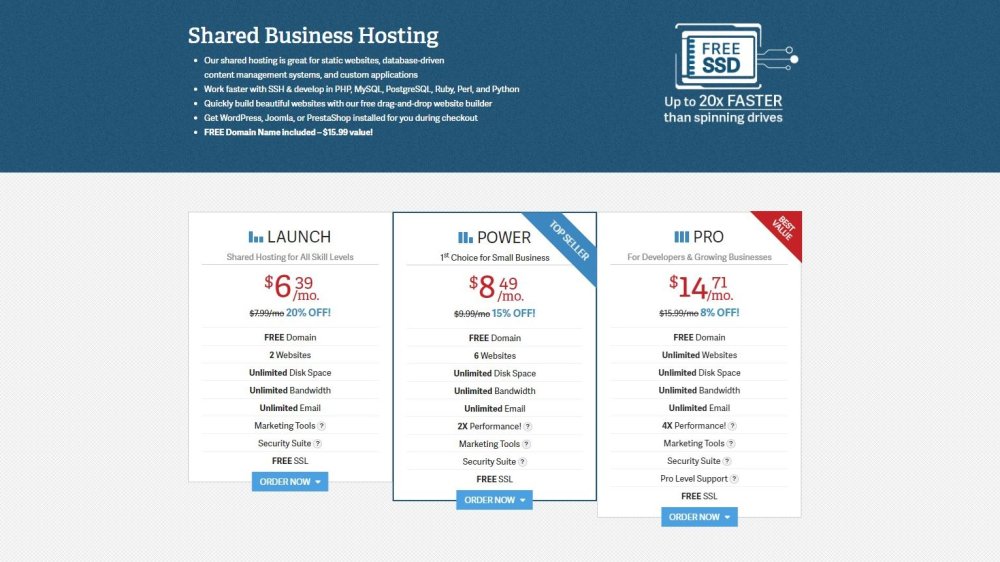
Image credit: InMotion Hosting
Costs and what's covered
InMotion has a number of web hosting products to choose from that cater to the needs of both businesses and individuals.
To give you a better idea of the company’s pricing, WordPress Hosting starting at $7.25 (about £6) a month, VPS Hosting starts at $19.99 (about £16) a month, dedicated servers start at $105.69 (about £95) a month and business hosting starts at just $5.99 (about £5) a month. However, in this review we’ll be looking at InMotion’s business hosting in much more detail.
InMotion’s ‘Launch’ plan gives you a free domain, two websites and unlimited disk space, bandwidth and email for just $5.99 (about £5) a month with its current promotion. Marketing tools, a security suite and free SSL are also included.
Next up is the ‘Power’ plan for $7.99 (about £7) a month, which raises the number of websites to six and offers twice the performance thanks to the fact that this plan has access to a greater level of server resources like RAM and CPU.
Finally, we have the ‘Pro’ plan for $13.99 (about £13) a month, which gives you access to unlimited websites, pro level support and four times the performance of InMotion’s Launch plan.
InMotion’s prices are competitive and if you check its site often, you’ll find that the company even offers occasional discounts to sweeten the deal. A 90-day money-back guarantee is just another compelling reason to try out the service for yourself.
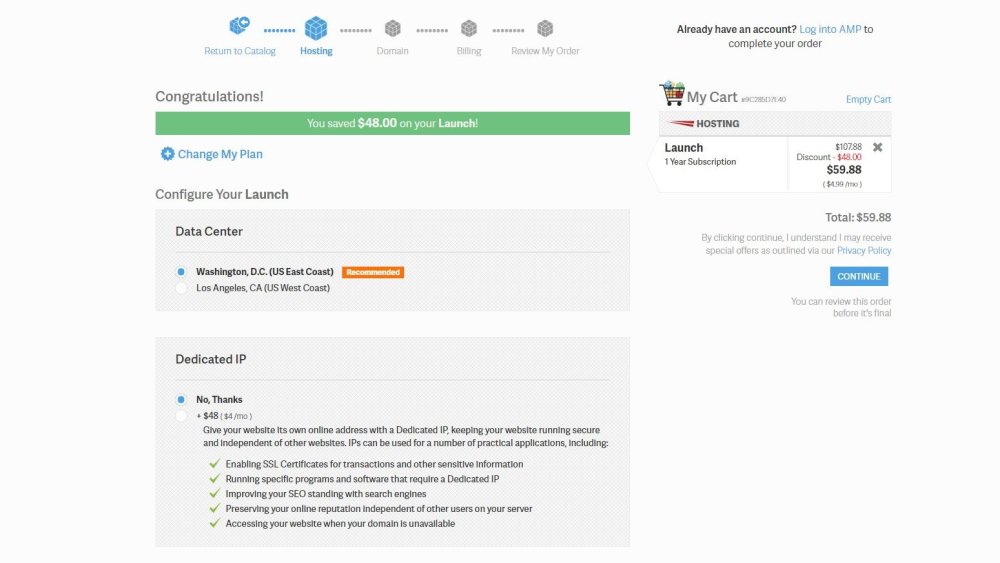
Image credit: InMotion Hosting
Signing up
From when you first visit its website, InMotion presents its hosting products in a clear and straightforward way with detailed prices and summary information. The company provides a table that helps you compare the features available in each of its plans, and you can even compare InMotion’s prices to its competitors right from its site. There's also an FAQ section to help you find any other answers you may be looking for.
After clicking the Order Now button, the site asked us to choose a domain name for our site. InMotion allows you register one domain for free with each of its plans or you can choose to use one you already own.
On the next page, we were able to choose whether we wanted our preferred hosting center to be in either Washington DC or Los Angeles, and we were given the option to have WordPress, Joomla, PrestaShop or BoldGrid preinstalled with our account.
Payment options are limited to credit or debit card, US purchase order or check. We would have liked to see PayPal as an option in this list, but this is by no means a deal-breaker.
Overall, the signup process was fast and, more importantly, honest as InMotion did not try to upsell us by encouraging us to add additional products or services to our order.
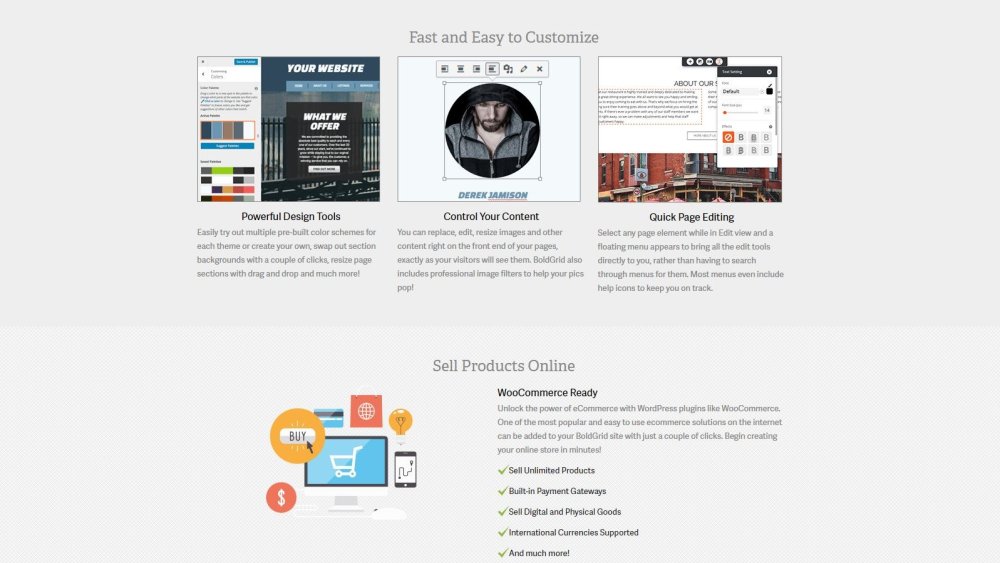
Image credit: InMotion Hosting
Creating a site
One area where InMotion particularly excels is its onboarding process. After signing up, new users are presented with a list of common starter topics (new customer’s guide, pointing to our nameservers, etc) and can pick the ones they need. InMotion then emails you links to these guides to help you get started.
Next we decided to give InMotion’s free website builder a try. Instead of being a standalone website builder such as Weebly, the company’s site builder is actually a set of WordPress plugins called BoldGrid which required a separate installation.
However, once we got BoldGrid up and running, the site builder was reasonably easy-to-use and also contained some well-designed templates as well as drag-and-drop editing. InMotion’s free site builder may lack some of the integrations of its competitors but since it doesn’t have any page limits, you can build a large site without restrictions.
The company also provides access to the Sofaculous framework which allows you to find, install and manage hundreds of popular applications including WordPress, phpBB, Joomla, Drupal and PrestaShop.
Experienced users will appreciate the fact that InMotion allows you to use cPanel to manage your site as well as standard tools including FTP, a file manager, SSH and more at their disposal.

Image credit: InMotion Hosting
Performance
When it comes to testing a web host’s performance, one of the first things we do is to take a close look at its support system, and InMotion left us thoroughly impressed. From the customer portal we could search the support database, and clicking on the Support button gave us links to useful guides, US-based support phone numbers, a form to create a support ticket, and even the ability to launch a live chat window to speak directly with a company representative.
The web support center provided us with a long list of all of InMotion’s resources. There are sections for Tutorials, Product Guides, Frequently Asked Questions, a community forum and more. Few of the web hosts we’ve reviewed have the sheer amount of content that InMotion provides and we found its support articles to be useful, relevant and up to date.
All of its guides are searchable and each document even showed the date it was uploaded on to give us a better idea of whether or not it was still relevant. Surprisingly, there is even a comments section where customers can leave questions and get responses right from InMotion’s staff.
To complete our performance tests, we tested our site speeds using Bitcatcha and other benchmarks to find that our connection was fast and that overall performance was well above average.
-
StrongVPN traces its roots back to 1994 when a small company selling PC computers was founded in South Lake Tahoe, California. Soon after, this company shifted its scope to providing dial-up Internet services. In 2005, StrongVPN was born, providing privacy services to users around the world and earning a place on our guide to the best VPN in 2019.
Plans and pricing
While most VPN providers have several subscription plans on offer (six-month, two-year, etc) with savings for longer commitment periods, StrongVPN has only two pricing options available: one-month and one-year. The monthly option costs $10 (about £9), while the annual subscription is more affordable, with a price of $5.83 (about £5) per month. Accepted payment methods include credit cards, PayPal and Alipay.
While there's no free trial per se, the company states its 30-day money-back guarantee is unconditional, which means you have quite a long period to check if the service is the right fit for you. If not, make sure you cancel the subscription and request a refund during this period.
Features
StrongVPN offers its users access to 650+ servers scattered across 46 cities, as well as access to 59,500 VPN IP addresses.
One of the standard VPN features provided by this platform is a kill switch – a valuable mechanism that protects your privacy in case of an unexpected VPN connection interruption. If this happens, the kill switch immediately disconnects your device from the internet.
Another common feature employed by StrongVPN is the automatic selection of the best available location, giving you highest speed possible while using the service.
Although the provider doesn’t have any special or proprietary features like its counterparts, it supports an unusually high number of simultaneous connections – 12. Moreover, it can be set up on a router, increasing this number to virtually infinite. The only catch is that the router itself has to be VPN-optimized, but you can consult the StrongVPN website or customer support for a recommendation.
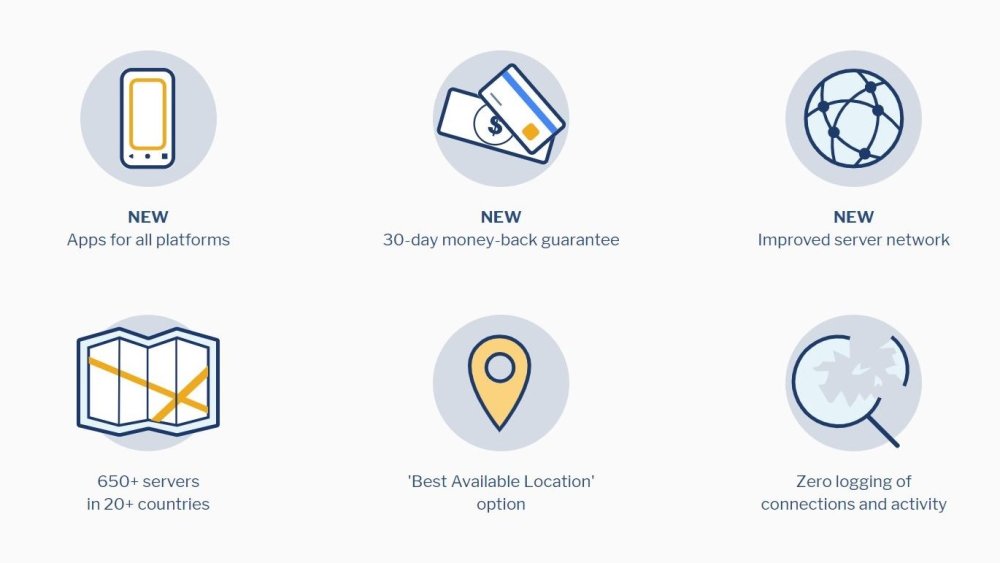
Image credit: StrongVPN
Privacy and logging
StrongVPN doesn’t stand out much from the crowd in terms of security and privacy either. The list of connection protocols lists all the familiar faces – OpenVPN, L2TP, SSTP, IKEv2, and IPSec – while strong encryption is provided courtesy of AES-256-CBC algorithm. The CBC mode of operation is used due to its performance advantages.
Additionally, the company uses its own secure DNS system called StrongDNS, which is also available as a separate service.
The usual no-logs policy is in force – StrongVPN doesn’t track or store any of your activity logs during its use. The company clearly lists the information it does collect - email addresses and payment information, for the purposes of creating your account. This information isn’t passed on to any third parties.
However, more details about the no-logs policy would be welcome, especially since the physical location of the provider (the United States) doesn’t exactly scream 'privacy protection'.
Specifically, in addition to having a bad reputation concerning the privacy of its citizens and outsiders, the US is one of the members of the so-called Five Eyes, Nine Eyes, and 14 Eyes alliances, whose members track information about individuals and businesses and share it with each other.
Performance
StrongVPN doesn’t disappoint in terms of performance. Download speeds and connection times are fast, while the connection itself is stable. Expectedly, the performance is greatest when using the US servers, dropping a little for servers in more remote locations. This is a common occurrence in this business, and doesn’t affect the overall performance greatly.
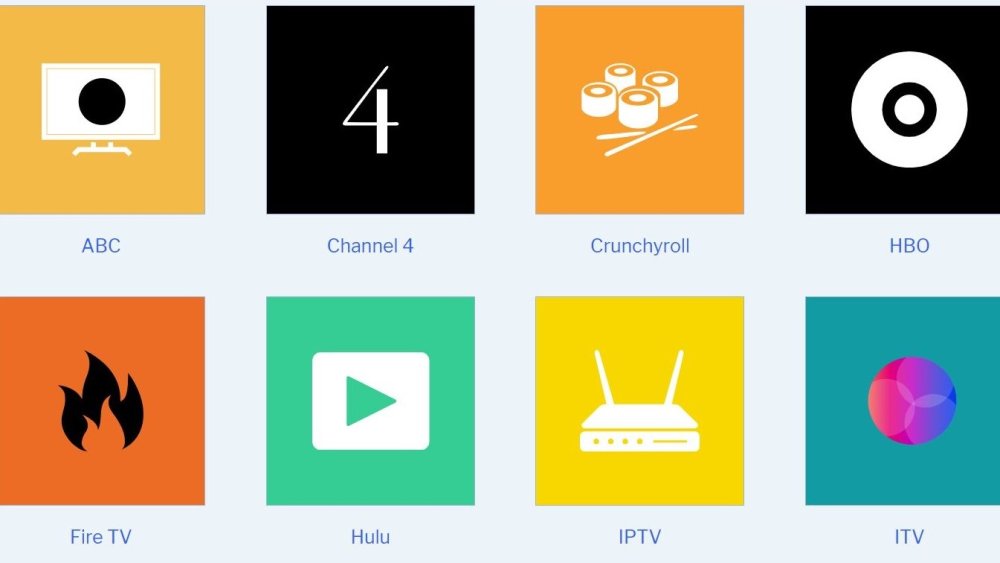
Image credit: StrongVPN
Netflix
StrongVPN is an excellent choice if you need a VPN for accessing popular streaming services like Netflix, Hulu, Pandora, HBO, Popcorn Time and Crunchyroll. It not only provides unhindered access to these geographically restricted services, but it does so at high speeds and unlimited bandwidth.
Torrents
If you decide to sign up with StrongVPN, you’ll also have unlimited, fast, and safe access to sharing large files via torrenting clients like BitTorrent. The provider makes this clear on its website.
Client setup
In terms of platforms, StrongVPN supports a vast range of options. Clients are available for download if you’re using Windows, Mac, Android, iOS, and Fire OS, while other devices can be manually equipped with a VPN with some help from the installation guides on the website or the customer support agents. These other platforms include Linux, Amazon Kindle, Nokia Symbian, routers, and many more.
The installation of the clients for major platforms is as simple as they come, and even if you do get stuck anywhere, the website and support agents are there for you.
Support
As mentioned above, support is available on multiple fronts. You can try browsing the website’s support section or typing in the term in the search box there and check the results. If this doesn’t address your issue, then it’s time to give a chance to one of StrongVPN’s helpful customer support agents at your disposal at any time of night or day, regardless of your time zone. They can be contacted via live chat on the website, as well as though email support.
On top of that, this provider is one of the rare ones that have phone customer support, available during work hours (Monday to Friday, 9am to 5pm Central Time).
-
Surfshark was founded in the British Virgin Islands – one of the rare havens of privacy with no data retention laws. The company currently offers anonymity services on 800+ servers on six continents, and is one of our recommendations for the best VPN in 2019.
Plans and pricing
Surfshark's services can be purchased under three plans. The one-month subscription plan comes at the price of $12.95 (about £12). It is followed by the one-year option at $5.99 (about £5) per month, while the price drops even further for the two-year plan and amounts to $2.49 (about £2) per month.
However, when you first visit the page, you’ll be offered a coupon that changes the pricing a bit. Namely, you are then offered the one-month plan at $12.95 (about £12), the two-year plan at $2.49 (about £2) per month, as well as the three-year option at as little as $1.94 (about £1.50) per month. This occasionally changes.
Accepted methods of payment cover credit cards, PayPal, Google Pay, and major cryptocurrencies (Bitcoin, Ethereum, and Ripple).
Should you need to test out the service before making a final decision, you’ll have access to a generous, risk-free 30-day money-back guarantee that allows you to get a refund regardless of the reason. This isn't exactly the free trial we were expecting as you still need to pay for a plan, but is certainly better than nothing.
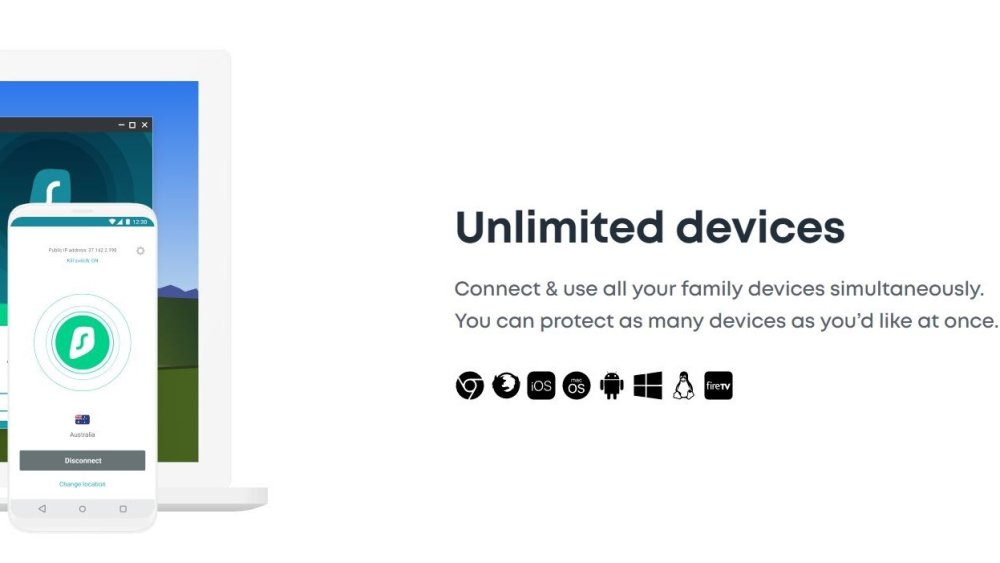
Image credit: Surfshark
Features
Surfshark has a decent server coverage, with over 800 servers scattered across more than 50 countries. It supports VPN connections on a virtually unlimited number of devices at the same time, putting it at the top of the VPN providers in this regard.
It deploys some of the usual VPN mechanisms, including a kill switch and split-tunneling. A kill switch is a must-have in the industry, as it provides protection of your private information when the VPN connection is terminated. When such a situation happens, a kill switch shuts down the device's internet access completely.
The extended split-tunneling technology, or as Surfshark calls it, the Whitelister, allows specific apps and websites to bypass the VPN should you choose so. Others are directed through the secure VPN tunnel.
As for the less common features, there's the MultiHop feature that allows connection to multiple locations at once, adding another layer of anonymity and footprint masking.
Surfshark's proprietary CleanWeb feature blocks ads, trackers, malware, and phishing attempts. More than the simple ad blocker, CleanWeb is useful for saving mobile data, facilitating a smooth browsing experience, and general peace of mind regarding your safety and privacy.
The Camouflage Mode prevents any outsiders from learning that you’re even using a VPN client.
Privacy and logging
Specific privacy features include the strong encryption ensured by the AES-256 algorithm, accompanied by the IKEv2/IPSec transfer protocol as default and, if you prefer, the optional OpenVPN protocol.
Surfshark also has zero-knowledge DNS on all of its servers, as well as a DNS leak protection when using the IPv4 stack.
The company clearly lists all the information it will never collect from you. This includes IP addresses, browsing activities, connection timestamps, bandwidth used, session information, network traffic, and so on. It does collect some other, albeit non-sensitive data needed to create your account, including your basic billing information and email address.
Although the no-logs policy hasn’t been verified yet, the provider has hired an independent auditor to confirm the security capabilities of its browser extensions. The results were satisfactory.
On top of that, your privacy is guaranteed by the fact that the company is registered in the British Virgin Islands, a place with no laws requiring organizations to retain any of their data logs.
Performance
Surfshark delivers excellent results for connection times, connection stability, and download/upload speeds. We did, however, notice that some of the servers don’t appear to be on their advertised location. That said, this minor issue doesn’t affect the general experience.
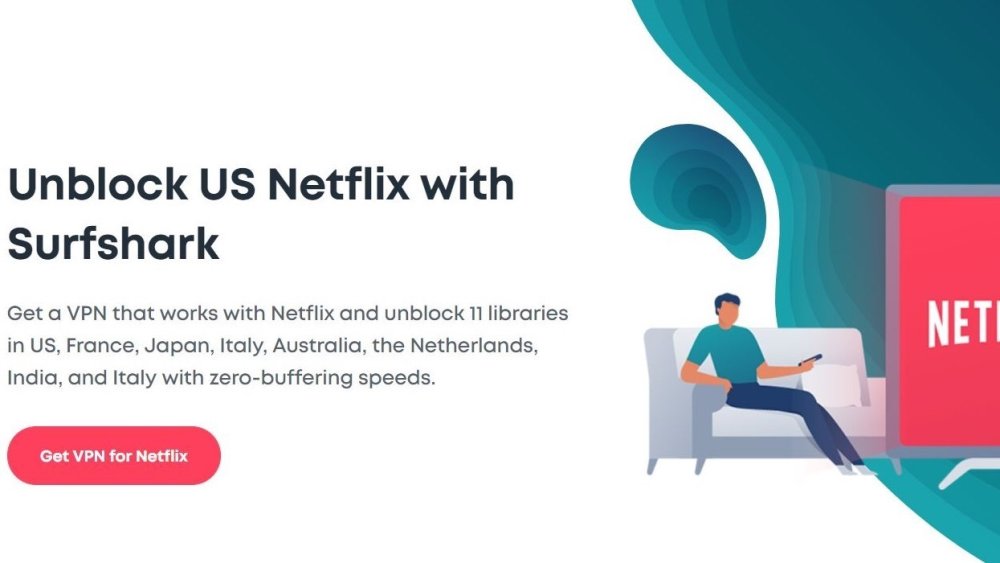
Image credit: Surfshark
Netflix
One of the most demanded VPN features is the access to geographically restricted websites and services, especially the ever-popular streaming giant Netflix. Surfshark will not disappoint you in this area, as it supports a long list of such services and websites, as well as providing access to Netflix libraries in eight locations, providing smooth streaming of your favorite shows.
Torrents
Another box to tick is torrenting capabilities. Unlimited sharing of large files via torrenting clients is allowed and supported, and explained in detail on Surfshark's website.
Client setup
Surfshark can be installed on a wide array of platforms such as Windows, Android, iOS, Mac, Linux, routers, select smart TVs, and even gaming consoles. There are also browser extensions available for Chrome and Firefox.
Support
Detailed information about every part of Surfshark's service is available on the company’s blog and searchable help page, which is divided into categories according to your area of interest.
If, after consulting the website, you still can't find the information you’re looking for, then we suggest contacting Surfshark's friendly staff, who are available 24/7 via the live chat button or email. Instead of going to your email provider’s website or app, you can simply send an email by filling out the form on the website.
-
G Data Antivirus is a complete PC security suite, and has earned a place in our roundup of the best antivirus software. Despite being G Data's entry-level antivirus software, it provides protection from exploits, anti-ransomware, URL filtering, spam filtering, and a dedicated browser that gives safety to online banking, shopping and any other financial transactions.
The program uses several technologies to keep you safe, including its own virus scanning engine. Also included is the Bitdefender engine, and a CYREN-based layer that can detect outbreaks instantly.
Single device licenses come in at $29.95 (£24) for a subscription that renews annually. Other top ranked competitors, such as Bitdefender Antivirus Plus and Kaspersky Anti-Virus have a similar subscription fee.
Savings are available for additional computers or extending the license term, so for instance a five PC, two-year license has an affordable cost of $94.95 (£75). There are also other solutions that have package deals for multiple devices, with multiple years of subscription.
A free trial is also available, along with the security of a 30-day money-back guarantee if you are not satisfied with the performance on your system.
Setup
The G Data Antivirus trial proved to be a simple download. Installation does take some time with the downloading of the components for setup, but beyond the initial step, everything proceeded nicely, without any further issues.
G Data requires new users to register by providing their name and email address. There is also a request for a physical address and phone number, but you can skip this step.
Right after we completed the main setup process, a window popped up and recommended we install G Data WebProtection. This is a Chrome extension for the prevention of phishing, scams and malicious sites. We prefer this to be controlled at the network level (rather than just a single browser), thereby ensuring coverage of all the browsers and our system apps. However, G Data claims this approach gives them higher accuracy- although we're kind of unsure how this would be.
Looking under the hood, G Data occupies 600MB of hard drive capacity, with seven new background processes that consume a full 250MB of RAM. With our system running full load, we did notice the negative impact on performance. We didn't independently measure this impact on performance, but we'll discuss what leading labs have found below.
Features
G Data Antivirus interface provides more information and options than its competition that take the more minimalist approach, and we appreciated this approach.
This includes an opening screen that doesn't dumb things down by glossing over the security status with merely the a ‘Protected’ caption, or a ‘All good!’ green tick, as some other antivirus solutions do. G Data indicates the system’s security status along seven protection layers, including the update details, system messages, and license information.
Clicking any of these will reveal a menu of related options. For example, clicking on Web Protection launches a menu with options to disable URL filtering, add exceptions, or open the Settings dialog for even additional adjustments. Additionally, the status lines for Real Time Protection, Spam Protection and other layers give quick access to frequently used settings – a convenient feature that optimizes the use of screen space and simplifies navigation.
The Virus Protection tab also makes it easy to jump to the links to launch the several types of scans: quick, full, check specific files or folders, removable drives, and scan for rootkits.
Scan times are faster than average, and G Data Antivirus detected each and every malware sample presented to it, with no false alarms.
To nitpick, we were annoyed with G Data's inability to run two scans simultaneously. With the program running a full system scan, attempting to initiate a second scan on the latest download from Explorer's right-click menu just gets a 'Can't do that, a scan is already running' message.
Thankfully, the URL filter performs without complaint, as it can block nearly all the threatening web URLs. We’re really not clear why G Data persistently recommends the installation of its browser extensions, though. Perhaps they do have a higher rate of detection, but this Chrome extension lacks configuration options while failing to add much to our eye.
The competent spam filter is a welcome addition, slotting nicely into our Outlook installation, and provides a nice array of options to tweak. We didn't go in-depth on it ourselves, but with our small sample, the module is a step up from the Outlook default Junk filter, and is close to a commercial anti-spam solution.
Some other G Data Antivirus elements were tricky to test. For example, the BankGuard and exploit protection elements endeavor to protect vulnerable processes by working deep inside the engine, but there was really no reasonable way for evaluating their performance for this review.
Next up is the Keylogger Protection module, which is designed for the protection of a limited number of applications, mostly just the popular browsers. We matched it up against a commercial keylogger program, and it didn't manage to record anything entered online. This security can be extended for other apps, but G Data does indicate that not all programs are compatible with this technology.
The Autostart Manager optimizes your PC by delaying the launch of the nonessential Windows startup programs. Let’s say that you've grown tired of that grabby Steam client sucking down resources with each system boot. Now, you can delay its start for two minutes, or a number you specify. Fewer starting processes at boot time gets us a PC that can get to work quicker, although the delayed programs will be loaded after the delay. While we like this feature, also bear in mind that there's excellent free software available that can also perform this function.
The control is via a slick settings dialog incorporating many opportunities to tweak. For instance, the Network Access dialog allows you to specify the network to use for downloading updates, and allows you to stop the program from chewing up bandwidth if on a metered connection.
G Data Antivirus doesn't have the most expansive feature list, but overall we like this product, as it does perform admirably at its core function: keeping users safe from malware.
Protection
While we do run some malware tests during antivirus reviews, we also check out the major testing labs which can run a full suite of testing, so it's critical to check out these reports for the most comprehensive picture.
Unfortunately, AV Comparatives hasn't included G Data products over the last few years, but AV-Test has tested them, and with positive results. The September/October 2018 Best Antivirus Software for Windows Home User reports the program gives protection from 100% of widespread malware, and approaches 100% on zero-day attacks, to give it the maximum protection score. The downside of this is that there was more than the usual impact on performance, which overall dropped G Data's score.
Next, we looked deeper into the performance questions, and turned to PassMark's Consumer Security Products Performance Benchmarks 2019 (Second Edition). This report assesses 14 security programs on 23 key points to examine how it impacts performance. Unfortunately, G Data falls short on this testing, placing in the lower half of the field in ninth place; only Avast/AVG, some Trend Micro products, and Bitdefender Internet Security got even lower scores.
While the low scores are disappointing, let’s place them in context. G Data does score strongly on at least some of the PassMark testing. Also, the true differences between the packages are fairly miniscule, and many value the security over the speed of the program anyway. For those that remain unsure, go ahead and peruse PassMark's report for all the finer points.
We aspired to have finish this review with a matchup between G Data Antivirus versus our custom ransomware simulator, which examines how this software can counteract the ransomware via behavior alone. This ended up being truly impossible, as G Data Antivirus closed down the file prior to us running it. Out of this experience, we can’t make a statement regarding G Data's behavior monitoring abilities, however, we can state that it is a champ when it comes to static file detection, and kept us totally safe.
-
Trend Micro Antivirus+ Security is a basic security suite that has all the essentials, such as real-time antivirus protection and malicious URL blocking, which has earned it a place in our roundup of the best antivirus software.
It also features some handy extras, including a Folder Shield, which provides ransomware protection to prevent any unauthorized access to designated folders.
The Trend Micro Pay Guard feature works with numerous browsers, including Chrome, Firefox and Internet Explorer. It provides a higher level of security for online banking and other transactions of a sensitive nature. A spam filter is provided via another add-on for Outlook, and we appreciate the inclusion as some other security vendors restrict it their higher-tiered security suite offerings.
Trend Micro Maximum Security is a great choice in comparison to other starter antivirus offerings, considering the low cost of $29.95 (about £23) for the single computer, one-year license. With lengthening the subscription to a full two years the cost increases to $59.90 (about £46), and locks in this current price for a longer time, but unfortunately doesn't deepen the discount.
Going up to the next higher tier, Trend Micro Maximum Security is a complete security suite with features that include a password manager, parental controls and social media protection. It works on all the major platforms and this includes PCs, Macs, Android and iOS devices, and has a more affordable cost than the competition. A single year license to cover five devices has a cost of $49.95 (about £39), and for ten devices, the two-year license runs $119.90 (about £93).
Setup
It’s unfortunate that the Trend Micro Antivirus+ Security web page tucks away the free trial link, and rather pushes the '30-day money-back guarantee' option. We think the company is probably hoping that users go ahead and purchase a license without further searching, so be wary. Instead, head to the Free Tools link at the top of the page, and go to the Free Trials area for the truly free trial.
The trial is actually for the full featured Trend Micro Maximum Security suite, but this interface is very similar to the lower tiered product, and provide the insight if Antivirus+ Security will meet your needs. We like that the trial provided covers a full 30 days, which is plenty of time to make up your mind if you want a full subscription.
Installation is pretty painless, with a simple download, followed by an automated setup process. With the conclusion of installation, users are prompted for their email address to be sent product news and updates, and this step in our experience was entirely optional (as it should be), as we left the box blank and the installer completed uneventfully.
With the program fully installed, it quickly faded into the background, with the only reminder as an icon in the tray of our system. This antivirus solution is admirable how it works unobtrusively, and you can forget that you have it installed.
We started off doing some initial exploring, and with the default settings, it did not live up to expectations. Trend Micro Antivirus+ Security smartly contains a spam filter, but unfortunately it is not enabled by default after installation, and further the interface does not highlight it at all. In fact, we only found this for ourselves after we looked into the Outlook interface, specifically for an elusive toolbar, with subsequently the answer then making itself known via the Settings dialog.
Focusing less on these minor details, and in the ‘big picture’ view, Trend Micro is quite simple to install, has an effective core antivirus engine, coupled with a full 30-day trial allowing adequate time if the subscription is right for your needs prior to purchase.

Image credit: Trend Micro
Features
The interface is clean and visually inviting, including animated icons, a scan button featured prominently, with your security status clearly indicated, as well as text captions and piles of tooltips. Additionally, there is a useful option to customize the console via a choice of a background image.
The Settings dialog follows the theme of simplicity as well. The confusing technical jargon gets avoided, and options are presented in easy to understand language, such as 'Prevent programs on portable drives from launching automatically' or 'Check if programs try to make unauthorized changes to system settings which could threaten your security'.
Some experts will seek even more control, but for those with no desire to get down in the weeds, Trend Micro's autopilot certainly has enough control for most users.
Scanning options continue to be straightforward, with simplified choices to do a quick, full or custom scan. Also the scanning efforts can be targeted to specific drives or folders. Unfortunately, total control of the process is not offered, as we are missing Avast’s options for adding other scan types, or controlling all the fine points of the process. On the other hand, we give it high scores when it comes to usability, and this will be preferred for those that just want a simple scan from their antivirus program.
Measured scan times were somewhat lower than average during the testing process, but that's not necessarily a problem; any program can run itself at ludicrous speed when scanning, and come up empty. Antivirus+ Security is thorough at what it does, as it seeks out malware. Too bad that it also gave a false alarm when it encountered several legitimate technical tools, such as the Nirsoft app, but if you've used security software before, you'll know that this is a fairly pervasive problem.
Additional security tools
One feature we particularly appreciated was the URL filtering, which blocked many malicious URLs when tested. The custom configuration options are also useful, which are a step above competing antivirus solutions, which are limited to only a switch for the URL blocking to be turned on or off, but this one includes a 'protection strength' slide bar, that can be increased to block more aggressively, or vice versa.
Trend Micro's Folder Shield is a useful feature that targets ransomware, a sentry over your Documents and Pictures folders, and connected USB drives, to protect from modification attempts on these files, and there is an option for additional folders as required. While we understand that Folder Shield is hardly novel, and Windows 10 already can do this with Controlled Folders, but an extra layer of protection is always a plus, and certainly when it can stop aggressive ransomware instantly.
Trend Micro's Pay Guard is a welcome addition, a highly secure browser to conduct online banking, shopping and other sensitive transactions. It is designed to thwart malware, rather than becoming a victim of it. Once again, hardly anything special, but including it in antivirus software is a bit of a standout.
Bitdefender SafePay and other secure software setups secure the environment in a custom browser constructed for safety. Alternately, Antivirus+ Security utilizes your favorite browser, as long as its Chrome, Firefox or IE, and then resets it to maximize the security settings. The benefit of this method is to preserve simplicity via the familiar interface, but also leaves us wondering on the level of security offered. We would that it is not as secure, with Trend Micro having less control over the browser functions, but to be quite frank, the reality is there is no way to really test how secure any of this is.
There is also a spam filter included, although Trend Micro doesn't mention it, and we randomly stumbled across it via the right page in the Settings dialog. It only works with Outlook, using POP3, SMTP and Exchange, and was added after the initial activation.
We also looked at the anti-spam capability, but it left a little cold. Trend Micro ended up incorrectly designating legitimate emails as junk, and on a routine basis. Some adjustments are permitted, as trusted addresses can be whitelisted as Approved senders, and and by moderating the filter’s strength.
The Link Filter tool has the ability to fully block emails based on their content, which includes links to known malicious websites – an excellent way for preventing contact with dangerous messages. While we would not consider it the most robust of spam filters out there, there are multiple settings to allow for fine level of tweaks, making it a useful addition to the suite.
Protection
AV-Comparatives is a real-world protection benchmark that tests 18 leading antivirus engines on the latest in malware. Its recent tests have found good results for Trend Micro, with their latest products able to block an awesome 100% of threats on nine different tests in 2018 from February to October.
The downside is that this program alarms falsely more than competitors, but still manages a first place ranking among 18 competitors in the February to June 2018 summary report. In second place was F-Secure- the other antivirus to achieve a 100% protection score- followed by Bitdefender (99.8%), Kaspersky (99.7%) and Avira (99.7%).
Testing in AV-Test's August 2018 Home Windows report confirms these results, as Trend Micro also scored a perfect 100% protection rate.
Differing from some of these other reports, SE Labs July to September 2018 Home Anti-Malware Protection report orders these programs via a scoring system with a high complexity, that gets determined by how the protection gets performed, and accounts if the malware threat is blocked on launch, or is neutralized after it gets running. In this report, Trend Micro falls down to sixth place, putting it behind some major competitors, including Kaspersky, Norton, Windows Defender, ESET and F-Secure.
However, getting down into the details, the difference in scores from the top down to Trend Micro is quite small, with first place scoring 100/100, and Trend Micro’s score a solid 98/100. In fact, Trend Micro still receives their AAA award, which is the top designation, confirming the strong performance.
We endeavored to confirm these tests, and we took Trend Micro and matched it against our custom ransomware software. With this program coming from our own design and creation, Trend Micro can’t identify this via a virus signature in its database, but rather has to turn to monitoring of the behavior to identify. Many antivirus products fall short when tested like this, and Trend Micro performed well.It not only neutralized the ransomware with a mere three files getting encrypted, but recovered all of them, with no loss of data.
The downside of Trend Micro surface when we look at system performance. PassMark's 2019 Security Products Performance report rounds up 14 security suites examining their impact on system performance on 23 different tests. Trend Micro's products that they tested, Maximum Security and Internet Security, both ranked on the lower end, in 12th and 13th place, which placed them quite low among the tested solutions.
We can certainly critique the methods used for PassMark's scoring, but additionally, the AV-Comparative's October 2018 performance test came up with similar results, placing Trend Micro in 13th place of their 18 tested antivirus programs.
Putting it all together, how Trend Micro performs on your PC is dependent upon your hardware, and how you use the software. Download the trial and give it a try to see firsthand the impact on your specific system before purchasing the subscription.
-
TunnelBear was established in Toronto, Canada seven years ago and bought by cybersecurity company McAfee in March 2018. It prides itself with a user base consisting of more than 25 million people all over the world, and has found a place in our roundup of the best VPNs in 2019.
There are just two pricing options. The one-month option costs $9.99 (about £8), while the price of the one-year option stands at $4.99 (about £4) per month. TunnelBear also offers a free account, albeit very limited, with only 500MB of allowed VPN traffic per month.
Although this is not enough for most users, it is nevertheless an opportunity to test the service out and see if it’s the right fit for you before committing to one of the paid options.
Both plans can be purchased using MasterCard, Visa or American Express, and the provider also accepts Bitcoin as the method of payment for the annual subscription option.
A 30-day money-back guarantee is offered if any unsolvable problems with the service arise.
Features
TunnelBear doesn’t really excel with its server count. Specifically, it provides access to an undisclosed number of servers in only about 20 locations.
Its list of features is also somewhat limited, although it does include the standard mechanisms like a kill switch. The provider gave its kill switch option a catchy name - VigilantBear, as the term kill switch 'sounds like a switch you activate manually in an emergency'. VigilantBear can be enabled in the client’s settings and it automatically stops your traffic in case the VPN connection is interrupted for any reason, thus protecting you from unencrypted data leaks.
The split tunneling feature called SplitBear gives you complete control over which apps will be directed through the secure and encrypted VPN connection, and which you want to leave on your regular Internet connection. Such apps include any that may restrict VPN access, or which you trust with your location/IP address, or any apps that might need your local IP address to work properly. That said, SplitBear is only available on Android devices running on Lollipop (5.0) or later.
Additionally, the GhostBear feature prevents outsiders from ever finding out that you’re using VPN software. Specifically, it changes your VPN traffic signature to appear as a different kind of traffic to third parties, like your ISP or government agencies. To accomplish this, GhostBear uses a technology called Obfsproxy which alters a number of identifying features like the size of packets or the order they’re sent in. All this means that the outside snoopers can’t block your VPN traffic. Having said that, GhostBear currently isn’t available on iOS devices, due to the restrictions in the way iOS is designed.
TunnelBear has a blocker feature for Chrome and Firefox extensions, which blocks simple ads and many types of online tracking that ad blockers tend to ignore, prevents fingerprinting, and facilitates faster website loading.
TunnelBear supports up to five simultaneous VPN connections with one account. If you were hoping to increase this number by installing the service on your router, you’ll end up disappointed as this provider doesn’t support routers.
Privacy and logging
TunnelBear offers strong protection of your privacy thanks to the encryption tools like the 256-AES algorithm and connection protocols that include OpenVPN and IKEv2.
TunnelBear's no-logs policy is pretty clear and detailed. It assures that it will not collect, store, or log any of your sensitive data, like IP addresses, DNS queries or online activities while using its services.
Unlike most other providers, TunnelBear has opened its proverbial doors to independent auditors, who have confirmed the quality of its security features for the second time in a row.
Performance
TunnelBear provider delivers superb results performance-wise. Not only does it connect very quickly, with the VPN connection remaining stable the whole time during its use, but it also facilitates top-notch download and upload speeds.
Although slight latencies can happen when trying to connect to servers in locations further away from your own, they don’t diminish the overall impression of the superior performance.
Netflix
Unfortunately, TunnelBear’s servers aren’t capable of defeating Netflix’s VPN blocking mechanisms. The same goes for BBC iPlayer and is one of the biggest disadvantages in the VPN business as many users look for a service that can provide them with uninterrupted access to these geographically restricted services. Geo-restricted YouTube content, on the other side, can be accessed with no issues.
Torrents
TunnelBear supports unlimited sharing of large files via torrenting clients on all of its servers. The performance, however, can sometimes depend on the server selected which is why you should contact the company’s customer service if you encounter any problems or need advice on which server to use.
Client setup
The list of supported platforms isn’t a long one. Beside having clients for Windows, Android, Mac, and iOS, the provider offers only limited support for Linux. It doesn’t support routers, any gaming consoles, Apple/Android TVs, Windows mobile devices, or e-readers. Browser extensions can be downloaded for Chrome, Opera, and Firefox.
The clients for Mac and Windows can be installed from the TunnelBear website, while the iOS and Android apps, as well as the Chrome, Firefox and Opera extensions can be downloaded via their respective app and extension stores.
Support
TunnelBear’s help section has a search box where you can enter the term you seek, or you can browse help topics according to their categories. If the support section fails to provide you with adequate information, you can contact the company’s friendly customer support staff.
Clicking the Contact Us link in the help section will take you to another page where you can describe your problem. Unfortunately, the provider doesn’t have a live chat feature, which is another disadvantage.
-
The product of the Swiss cybersecurity giant Golden Frog, VyprVPN was created in response to governments’ spying of people and entities, and its commitment to security has resulted in a high score and a place in our list of the best VPNs in 2019.
Plans and pricing
VyprVPN offers two types of subscription: Standard and Premium. These are available under either a one-month or a one-year plan.
The Standard monthly subscription comes at a price of $9.95 (about £8), while the Standard yearly plan costs $5 (about £4) per month.
The Premium account’s one-month plan will cost you $12.95 (about £10), while the annual option is a lot cheaper: $6.67 (about £5) per month. Accepted payment methods include PayPal and credit cards.
The free trial is a very short one – you only get three days to try out the service and see if it’s the right fit for you. Moreover, you still have to sign up for a subscription; you just aren’t charged for it during the first three days. You have to cancel your subscription if you don’t want the provider to charge you for the full subscription.
The website makes no clear mention of any money-back guarantee, so it’s difficult to say if you’ll be issued a refund if there’s a problem with the platform.
Features
VyprVPN has over 700 servers in more than 70 locations. On top of that, it has 200,000 IP addresses that you will have access to if you sign up for an account. It's one of the rare tier-one VPN platforms, which means it owns and manages all of its servers. This means that the provider’s servers deliver higher speeds and better connection stability than others’.
VyprVPN lists the usual features. A kill switch is activated when your VPN connection is disabled, blocking all internet traffic on your device so that your private information remains safe.
A split-tunneling feature, called Connection Per App, lets you select which apps will be directed through the VPN tunnel and which will be left outside of it, on your regular internet connection. An additional option is available - selecting which apps will connect only when the VPN is on.
The provider’s Android app deploys URL filtering – a tool that keeps malicious websites away from your device.
The VyprVPN Windows client is equipped with a built-in speed test, providing users with accurate information about the VPN connection speeds.
The Standard subscription supports up to three simultaneous connections, while the Premium one allows you to connect as many as five devices at the same time. The Premium account also comes with the VyprVPN Cloud – an added layer of security when accessing cloud servers, currently available for Amazon Web Services, DigitalOcean, and VirtualBox. The maximum number of simultaneous connections can be further increased by installing the service on one of the supported routers.
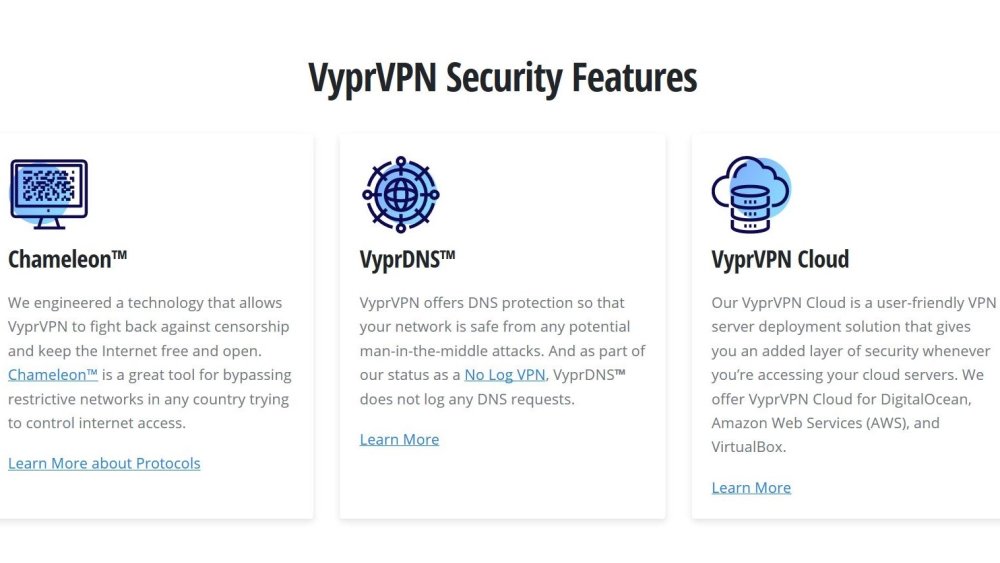
Image credit: VyprVPN
Privacy and logging
The military-grade privacy protection is guaranteed by the use of the impregnable 256-bit AES encryption algorithm and multiple connection protocols. These include OpenVPN, PPTP, L2TP/IPSec, as well as the company’s proprietary Chameleon protocol.
Chameleon is only available to Premium users. It uses the unmodified OpenVPN protocol and scrambles the metadata in order to bypass snooping and restrictive practices such as deep packet inspection, VPN blocking, and throttling. Chameleon is available for Windows, Mac, Android, and routers.
An additional level of security is provided by NAT Firewall which runs on all of the provider’s servers and blocks all unrequested inbound traffic when you’re connected to VyprVPN. This protects you from identity theft and spamming caused by malware that may reach your device through Internet connections left open by your applications.
VyprVPN also offers DNS protection, keeping your network safe from any potential man-in-the-middle attacks.
VyprVPN’s no-logs policy adamantly states that it doesn’t track or retain any user activity while connected to the service. While many VPN providers claim the same, they often make no effort to prove it. VyprVPN, on the other hand, has hired an independent firm to conduct a full and complete audit confirming its absolute devotion to transparency. The provider passed the audit with flying colors.
Performance
The VPN connection times and speeds are superb. The connection is not affected by any instabilities or errors. That said, some latencies can occur when using certain, more distant server locations but this issue doesn’t particularly affect the overall performance.
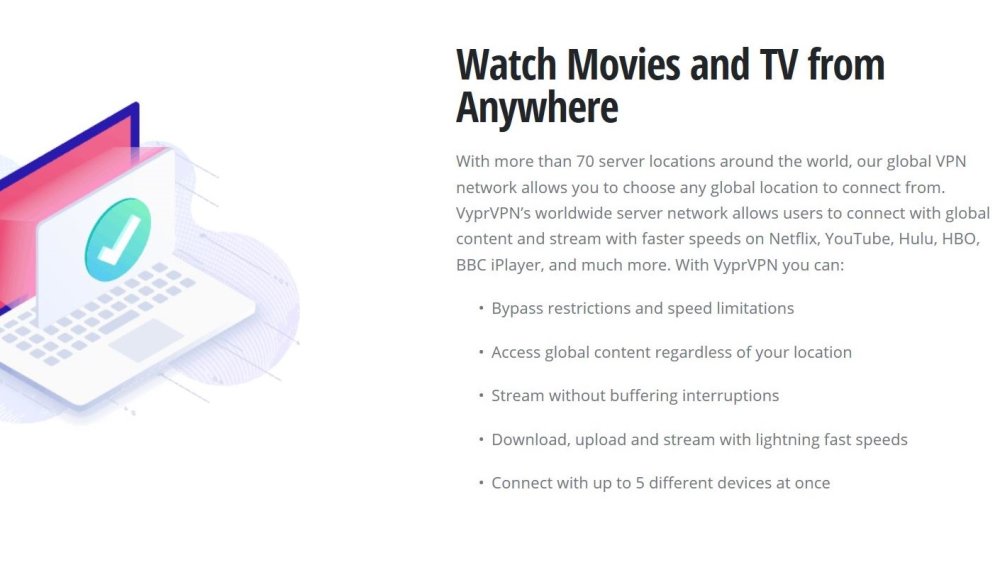
Image credit: VyprVPN
Netflix
VyprVPN prides itself in providing its users with unlimited access to services that are unavailable in certain regions. These services include the ever-popular Netflix, as well as BBC iPlayer, Hulu, HBO, and Amazon Prime. If you encounter problems while trying to access any of these services with VyprVPN, the website has resources to help you out.
Torrents
Although not heavily advertised, torrenting is allowed while using VyprVPN’s platform. If you dig around the website a bit, you’ll find that this is substantiated by the company’s assertion that: “Because our service treats all traffic equally, peer-to-peer and BitTorrent traffic is allowed.”
Client setup
VyprVPN supports the installation of its software on a long list of devices. Therefore you can download clients for Android, iOS, Windows, and Mac, as well as install the service manually on Linux, Blackberry, QNAP, Anonabox, Blackphone, and various smart TVs and routers.
The installation of the clients on major platforms is intuitive and simple but if you do get stuck somewhere, help is available on the website or via customer support. The website’s help section also provides manual installation guides for all other supported platforms.
Support
In addition to the exhaustive support section on the website, VyprVPN also has knowledgeable customer support experts at your disposal 24/7. You can reach them via live chat on the website or email.
-
Windscribe is a VPN company established in 2016 in Richmond Hill, a city in south-central York Region in the Canadian province of Ontario. Its VPN platform offers a very impressive collection of features, plus flexible pricing plans, making it one of our recommendations for the best VPN in 2019.
Plans and pricing
The provider’s free plan comes with a 10GB of available monthly traffic. If your requirements exceed this limit, then two paid plans are available by default - the one-month and the one-year option, at $9 (about £7) and $4.08 (about £3) per month, respectively.
Windscribe also allows you to create your own plan, purchasing only the servers you want for $1 (about £0.80) a month each. The only condition is that you purchase at least two locations. Each location you select adds 10GB more to your free bandwidth. Payment options include credit cards, PayPal, gift cards, cryptocurrencies, and more.
If any problems arise with the service, you’ll only have three business days to ask for a refund and only if you haven’t exceeded the 10GB traffic limit.

Image credit: Windscribe
Features
Windscribe has servers in 110 cities across 60+ countries, but only 10 of these locations are available with the free plan.
The provider’s Windows and Mac apps have a firewall, which blocks all connectivity outside of the VPN tunnel to protect you from any possible leaks. Moreover, Windscribe deems its firewall superior to a regular kill switch, which it calls a 'reactive measure' that still entails a risk of packets leaving your computer over the default gateway (your ISP).
The browser extensions have a few perks of their own, such as spoofing your computer’s timezone to match the location you’re connected to via VPN. This prevents websites from finding out you’re using a VPN when they check the timezone of your computer.
The extensions also feature the Split Personality option, which prevents browser fingerprinting by rotating your browser’s user agent each time you open it.
The Anti-Social feature blocks all social media trackers on the websites you visit, while the Ad Blocker defeats all those pesky ads.
Windscribe’s desktop clients have the unique capability to import custom OpenVPN configuration files from other providers, listing those servers next to its own.
If you choose one of the paid plans, you will be able to secure up to five devices at the same time (the free plan allows only one). This number can be further increased if you enable the service on one of the routers that support it.
Privacy and logging
The impenetrable encryption is ensured by the use of the 256-AES algorithm, accompanied by the SHA-512 authentication.
To protect your privacy, Windscribe also relies on the usual transfer protocols: IKEv2 and OpenVPN. IKEv2 is used as a default and recommended by the provider itself, ensuring the best possible performance.
Windscribe has its own proprietary, fully customizable DNS-based blocker option called ROBERT, which blocks the content you choose to block, such as malware, phishing, botnets, ads, tracking domains at the DNS level and more.
The no-logs policy lists the usual guarantees: not to store connection or session logs, your online activities or IP timestamps. The only information collected is for the purpose of enforcing the free plan and prevent abuses, and it includes the amount of data transferred on a monthly basis as well as when you last used the service.
Although these claims aren’t easy to substantiate without an outsider audit, the company still makes an effort to prove its dedication to your privacy. Namely, every year it publishes a Transparency Report where it lists all the data requests received from the DMCA and other organization with which it could not comply because there is no data to share.
That said, keep in mind that Canada, where this provider is based, is one of the Five Eyes countries (along with US, UK, Australia, and New Zealand), which share intelligence data among each other and aren’t exactly the poster children of privacy protection.
Performance
Windscribe provides excellent performance in terms of download speed, connection times, and stability, provided you use the default IKEv2 protocol. The results are slightly poorer with OpenVPN although not terribly inferior to IKEv2.

Image credit: Windscribe
Netflix
One of the most sought-after features in the VPN industry is access to popular streaming services that limit their usage in certain regions due to company policies or other reasons. These include the ever-popular Netflix, whose US, UK, Japanese, and Canadian libraries can be accessed via special servers cleverly named Windflix. Unfortunately, the provider currently lacks support for unblocking BBC iPlayer, Amazon Prime, and some other streaming services.
Torrents
Most of the provider’s servers are P2P-optimized, which means that unlimited torrenting is supported. The servers that don’t support torrenting are indicated in the clients.
Client setup
Windscribe can be installed on Windows, Mac, Android, iPhone, Linux, Amazon Fire, Windows Phone and many, many more, with clients available for the major platforms and manual installation guides for all the supported platforms.
Support
If the website’s large library isn’t enough to address all your concerns, then the friendly customer service agents are there for you. You can reach them through chat, email and even Reddit, although the company doesn’t have many agents at its immediate disposal so you might need to wait for a while to get a response.
-
Israel-based Wix is a giant of the website builder industry, and undoubtedly one of the best web hosting services around, with over 150 million users worldwide. Despite being founded in 2006, the company hit its first million users in 2009 and today it has 2,770 employees with offices in Israel, the US, Lithuania, Germany, Brazil, Ukraine, Ireland and Canada.
Unlike traditional website hosting services such as GoDaddy or InMotion, Wix is a website builder first with free web hosting thrown in as an added bonus. The decision to bundle its plans with free web hosting fits perfectly with the company’s goal to enable anyone to create a professional website quickly and easily since its customers won’t have to spend time shopping for a web host and can instead focus on building their sites. With Wix, users can build their site using the company’s drag-and-drop editor or they can even have it created automatically by using Wix Artificial Design Intelligence.
So let’s take a closer look at the service’s plans, features and pricing to see if this website builder is the right fit for your website.

Image credit: Wix
Costs and what's covered
While Wix does offer a free plan that gives you access to hundreds of templates, unlimited pages and top graded web hosting, the company’s premium plans give you even more.
Wix’s premium website plans start with its Combo plan for $11 (about £9) per month, which gives you 2GB of bandwidth, 3GB of storage, the ability to connect your domain, 30 video minutes and a free domain for one year.
Next up we have the ‘Unlimited’ plan which is geared towards entrepreneurs and freelancers. This plan costs $14 (about £11) per month and includes all of the features of the combo plan as well as unlimited bandwidth, 10GB of storage, one video hour, $300 (about £270) in ad vouchers, Wix’s site booster app and its form builder app.
Wix’s Pro plan costs $19 (about £17) per month and includes all of the features of the Unlmited plan as well as 20GB of storage, two video hours, events calendar, professional logo and social media logo files.
Finally, we have Wix’s VIP plan, which includes everything the Pro plan does, but also comes with first priority support.
It is also worth noting that the company’s free and Connect Domain plans include Wix branding at the bottom of your site. However, Wix’s premium plans don’t include any branding at all.
Signing up
Once you’ve chosen your plan, Wix asks you to enter your email address and a password. The company then runs you through a series of questions to determine what kind of site you want to create and who your audience will be. Once you’ve completed the questionnaire, you’re then asked whether you would like Wix Artificial Design Intelligence (ADI) to build your site for you or if you would prefer to create it yourself using Wix’s drag-and-drop editor.
If you’re still not sure which option is the best for you, Wix does have an article in its help center titled Creating a new site: Editor vs ADI that could help point you in the right direction.
Overall though, Wix’s signup and account creation process are fairly straightforward, and the option to connect your Google or Facebook account (as opposed to making an entirely new one) is a nice touch.
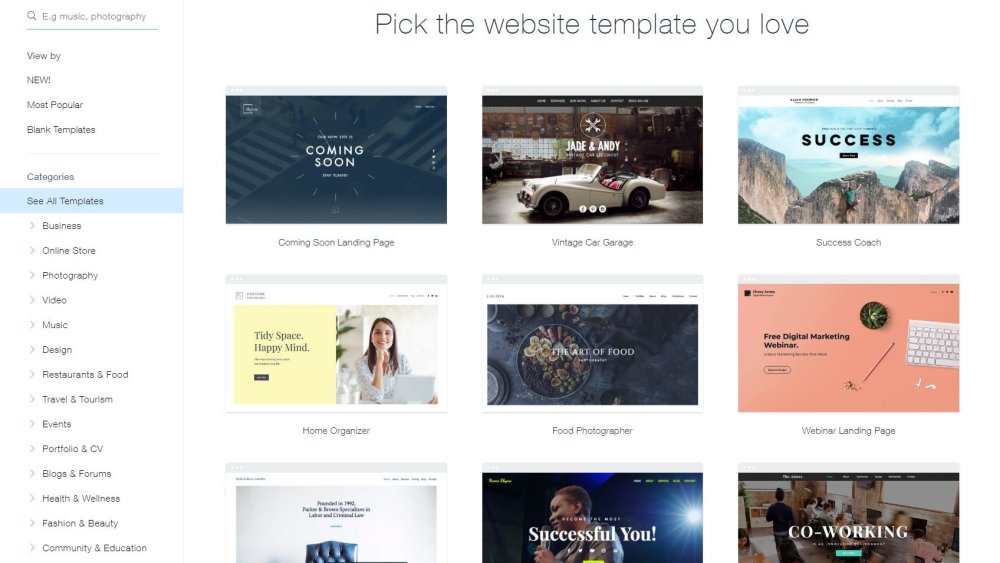
Image credit: Wix
Creating a site
As we mentioned before, you can use either Wix’s regular editor or ADI to create your site. ADI lets you create a site in almost no time at all but the editor is much simpler. All you have to do is tell Wix the type of site you want to create, the features you need (selling online, taking appointments, getting subscribers, a blog etc), import some of your social media and contact details and ADI quickly creates a site to match.
The regular editor takes a much more manual approach. You start with a template which you can customize by dragging and dropping the full set of Wix components onto the page or adjusting the elements you already have.
This approach gives you more control over the layout of your site but there is also a significant drawback. ADI allows you to change your layout after you’ve created your site but once you have selected a template in the standard editor, you’re unable to switch it later.
One of the best things about Wix is its polished user interface. All of the design elements in its editor are available via a toolbar to the left while importing media and accessing settings can be done via a toolbar at the top of the page. There are also guidelines down the center of each page to help you line up your content accordingly.
Wix is a very design-focused company and you can tell that just from visiting its website. It’s great to see that this attention to detail carries over to its website builder as well. If you’re an experienced user, you’ll be right at home and if you’re a beginner, you’ll be able to pick things up rather quickly especially since help is available right from within the editor itself.
Even if you’re just a beginner when it comes to website building, we still recommend using the regular editor as the learning curve is not too difficult. However, if you need to get a site up and running immediately, then ADI might be the better option.
Performance
When reviewing a website hosting service or even a website builder for that matter, the first thing we do is to look at the support options on hand. Thankfully Wix has a lot of built-in support. For example, left-clicking any object in the editor displays a toolbar with a help icon and a help menu is always visible in the editor’s own toolbar.
If you do access help from within the editor itself, it will be displayed in a small pop-up window which is quite handy as it doesn’t take you away from the work area. However, you can also go to Wix’s Help Center via your web browser to sell all of the articles and commonly asked questions in a full browser window.
Wix’s knowledgebase provides users with a number of useful articles on a variety of topics including the Wix Editor, domains, mobile, SEO, Wix Stores, ADI and more. These articles are presented well and many include animated GIFS to help illustrate interface actions for those who need extra help. Wix’s support articles are also tailored to both beginners and experienced users.
If you need further help, customer support is available via a ticket system though unfortunately there is no live chat option. Telephone support is also available, but your only option is to request a call-back, which can be frustrating when you’re in the middle of troubleshooting an issue.
-
In the 21st century, sharing files, audio, and video is a regular part of our work and daily lives. But converting files to different formats can be a pain.
To do this, you need a tool like Video Master that can easily convert media files to over 50 different formats.
Video Master is super fast to use, and can convert files with just one click. With it, you can download videos from over 100 platforms, including YouTube, Dailymotion, and Vimeo. You'll also be able to record videos directly from your screen.
Video Master even has built-in tools that enable you to edit your own videos, enabling you to trim footage, crop videos, add subtitles, and much more.
Best of all, you can get a lifetime license for the low price of just $29.
Related articles:
-
In web design, great user interface, or UI design, is all about helping the user to accomplish a given task as simply and efficiently as possible. While the look and feel is undeniably important, at the core of a great UI is function: in terms of navigation, it should be intuitive to the point of being invisible. As soon as a user gets lost, or can't work out where to go, the UI's not doing its job, and there are plenty of examples of painful UI fails to demonstrate what you shouldn't be doing.
This list of websites and apps may have different design principles and different functions, but they have one thing in common – effective UI design that satisfies all of the above and more. Read on to find out why they're so successful.
01. Montreux Jazz Festival
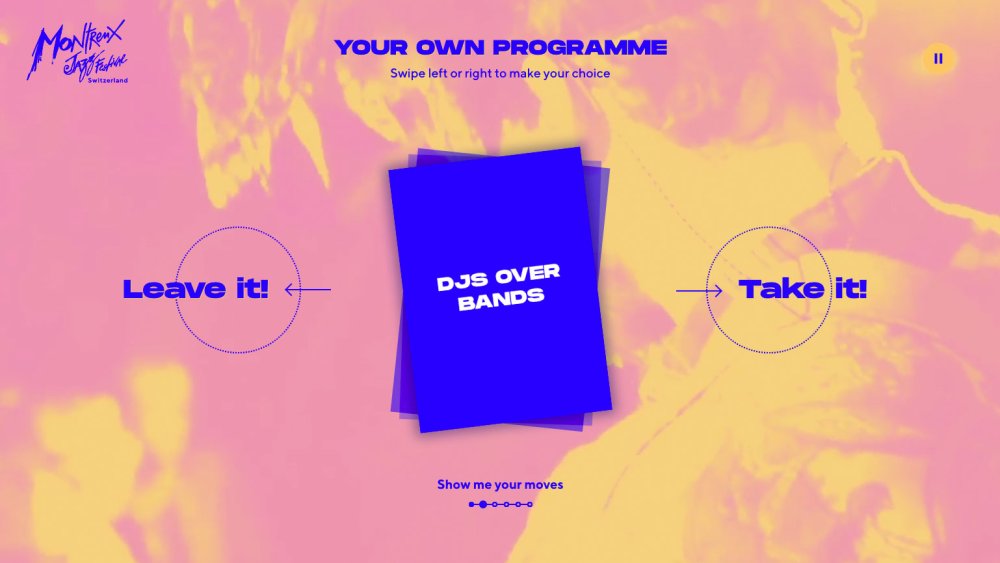
Here's a fantastic way to build your own tailor-made festival programme with a few swipes
There's nothing like being at a festival to get your FOMO levels through the roof; sure, you might be enjoying the act you're seeing now, but maybe there's another even better one happening elsewhere that you don't even know about. No matter how many times you comb through the long list of performers, there are bound to be a few absolute gems that you miss. But this great piece of UI design for the Montreux Jazz Festival aims to help you ensure that you get the very most out of your time there.
It keeps things beautifully simple, presenting you with six binary choices that you can swipe left or right to build up an impression of your musical preference – for example, do you prefer DJs over bands? – and once you're done it'll present you with your own personalised programme based on what it thinks you'll enjoy, complete with links to buy tickets.
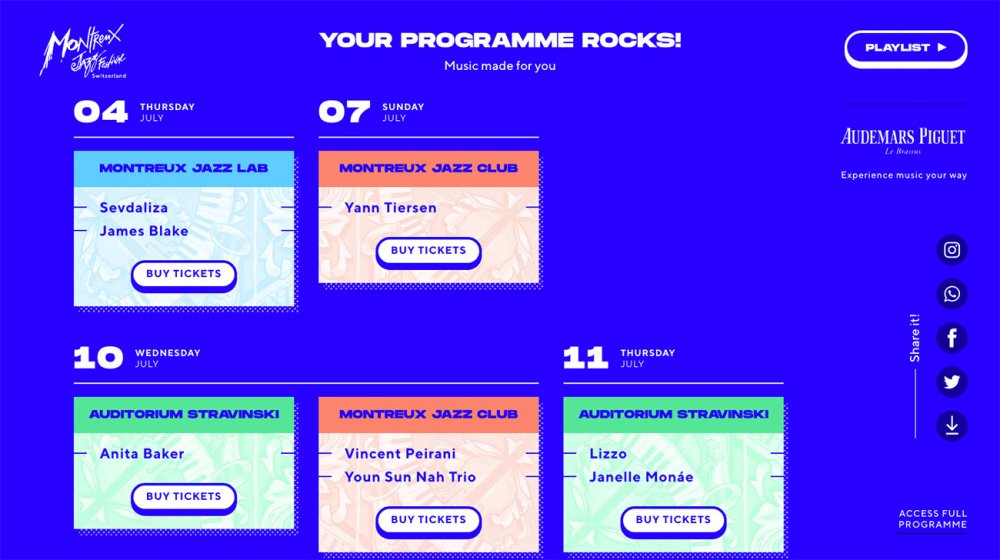
Lizzo! How did they know?
It's easy and intuitive and, while you'll doubtless want to double-check the full programme anyway to make certain that there's definitely nothing you've missed, it's a brilliant way to help you drill quickly through a lot of information to find results.
02. Tilt Brush
Virtual reality is very much frontier territory as far as UI and UX is concerned. It's designers and developers having to make stuff up as they go along, with naturally mixed results. What works on a flat screen doesn't necessarily work so well in VR, and building an effective and useful VR app that you can use for hours without getting motion sickness can be quite a challenge.
So it's great to see a VR product like Google's Tilt Brush – which lets you build up 3D paintings in a virtual environment – that not only works, but is so intuitive to use, and with such great results that artists are already incorporating it into their creative workflows. Head this way for some excellent pro tips on getting started with this game-changing creative app.
03. Patterning

Patterning's circular, minimal approach makes it easier to roll your beats [Image: Olympia Noise Co]
Olympia Noise Co's iOS drum machine, Patterning, is unlike any you've seen before, and with good reason. Rather than sequence your rhythm on a grid like every other music app, Patterning uses a circular interface for the basic business of laying out your beats, with colour coded drums so that you can easily see what's what.
And beyond the basics, Patterning's smart but minimal UI makes the more complicated business of sequencing longer songs out of individual patterns a lot less challenging, enabling you to easily create variations on patterns and then fit everything together. It takes a similarly straightforward approach to making everything sound better, too; both its mixer and FX interface are thoughtfully laid out with bold visual cues that help you get the sound you want without getting bogged down among inscrutable controls.
04. MailChimp

MailChimp's design is clean and flat and largely typographical [Image: MailChimp]
Newsletter creation and management may not be the most exciting task in the world, but the beautifully designed, intuitive user interface design of MailChimp makes it that much more palatable. Since its recent redesign, the web UI is clean, flat and primarily typographical.
When your account is first set up, the classic 'empty account' problem before your first campaign gets off the ground is balanced out by helpful, visually pleasing user guides. There's plenty of white space, and clear calls to action walk new users through every step of the process - in some cases even incorporating a subtly-animated pointer to indicate where to click.

Helpful calls to action prevent you getting lost in MailChimp [Image: MailChimp]
05. Paper for iPad

Paper is designed to be intuitive to use [Image: FiftyThree]
A multi-award-winning app designed to help users be creative in a more intuitive, natural way, Paper lets you draw with your fingertips with a surprising level of detail - although it also works with a stylus if more precision is required.
Designed exclusively for touch, Paper's UI design has no buttons or settings to worry about – just a series of specialised tools. The versatile fountain pen-style Draw tool comes free, while Sketch (soft pencil), Outline (bold marker), Write (ink pen), Color (watercolour brush) and Mixer (colour blender) come as in-app purchases.

Rather than buttons, Paper has a set of specialised tools [Image: FiftyThree]
06. Things
Available for both Mac and iOS, Things is a popular task management app with an award-winning design that's intuitive and easy to pick up, based around the familiar to-do list concept. As its creators Cultured Code point out, the idea is to make your life easier, after all.
The slick, clean user interface design comes pre-divided into lists to help you categorise your tasks: urgent things go in 'Today', slightly less urgent can wait until 'Next', while 'Schedule' plans further ahead. Each entry captures important information in one go – title, notes and due date, as well as tags if required to help categorise everything. Best of all, the Quick Entry window is accessible from anywhere using a simple keyboard shortcut – and it's all synced automatically across desktop, iPhone and iPad.
07. Campaign Monitor: Worldview
Worldview lays out complex data in an accessible way
A wonderfully original idea that puts an engaging twist on email subscription data, Campaign Monitor: Worldview overlays information about individuals who are opening, clicking and sharing your communications on a Google Map in real-time for both geographical and personal insights.
The landing page introduces the concept in an immediate visual way, with example pins dropping onto a world map – and the application interface itself is refreshingly clean, revolving around the map and a few basic menus for controlling settings. A great example of UI design, with simple iconography and colour coding identifying different categories of user engagement at a glance.
08. Figure

Figure's designed to help you bang out tunes on the go [Image: Propellerhead]
Yet another example of flat design making a potentially very complicated UI design look very clean and intuitive, Figure is a synthesiser and drum machine for iOS from Swedish developer Propellerhead, which is also behind desktop music production software Reason.
You can tap the touch-screen pads, hold your finger down and scroll the rhythm wheels for a range of different sounds, or swipe across the screen to play different notes in the scale. There are also wheels to control the range of notes you have to work with, the number of notes in melodies and bass lines, and various tabs to tweak the sound in a variety of ways.
09. Kennedy

Kennedy adds context to your memories [Image: Brendan Dawes]
There's nothing quite like scrolling through a load of your old Twitter updates and wondering what in the hell you were thinking of when you posted that thing six months ago. Lack of context can often mean that something that made perfect sense at the time can be rendered meaningless months or years down the line.
Kennedy, a diary app from the ever-excellent Brendan Dawes, is designed to add context to your memories. You can use it to create text notes of what you're up to, just like you might type into Facebook or Twitter, and maybe add photos to the notes while you're at it. The clever touch, though, is that Kennedy then adds an extra layer of context by adding your location, the date and time, the current weather conditions, a news headline and, if you're listening to music on your phone at the time, the name of the track you're listening to.

Kennedy's added details make a rich alternative to dry notes [Image: Brendan Dawes]
The result is that instead of a dry note that won't really mean much down the line, you capture a particular moment with fuller context, complete with plenty of prompts that can help bring back a memory in much more detail. And Dawes' clean design and smart UI keeps everything simple and good-looking.
Related articles:
-
Us by Night is unique among design and creativity festivals, because it takes place in the evening: a much more civilised time to network, learn and be entertained.
Taking place in Antwerp this 26-28 September, Us by Night is also a great excuse to indulge in the delights of this Flemish city, which is an intoxicating melting pot of creative practices, multicultural artists and innovative tech businesses. Not to mention the arcade, the night market, the delicious local food, and the fluorescent ping-pong!
But of course, the biggest reason to head to Us by Night are the top-flight speakers, and one of the top draws this year will Gary Card.
Who is Gary Card?
London-based designer, illustrator, artist and sculptor Gary Card is known worldwide for his dreamlike scenes and whimsical designs for the likes of Nike, Hermès and Comme des Garçons, as well as designing album covers for Paul McCartney and costumes for Lady Gaga.
Now, he's about to take over Phillips‘ London Gallery for a major private-sale exhibition, called Hysterical. For this, he's created a colourful, cartoonish wonderland as a backdrop to works by contemporary artists.
We caught up with Gary to find out what makes him tick, what he'll be talking about at Us by Night, and why no one should miss it!
What will your talk at Us by Night be about?

Last year, Gary transformed Covent Garden’s Galeria Melissa into "Medusa’s lair"
My forthcoming exhibition, Hysterical. It's by far the biggest thing I've ever worked on, getting to re-contextualise some of the work from my art heroes. I want to talk about the whole process and what brought me there.
What's the inspiration behind it?
I've always been interested in the concepts of high art and low art, and the space between them. What makes something high art? Many artists that I admire have explored this division through the use of cartoon imagery.
Who, for example?
Illustrators such as Robert Crumb and Basil Wolverton have explored this world for 40 years and are now being reassessed as serious artists worthy of their place in the canon. George Condo, Paul McCarthy, Ugo Rondinone are all artists who've inspired my work, and whom we have chosen to feature in this show. They all draw on inspiration from pop culture to explore ideas of great depth and feeling.
McCarthy for me, in particular, has chosen to scratch beneath the joyful, seemingly harmless exterior of our favourite cartoon icons to reveal subjects that make his work so unsettling. Younger artists like Jordan Wolfson and Jamian Juliano-Vilani are picking up that mantle.
This strange corner or contemporary art has brought me to the world of Hysterical, a cartoon fun house, which extenuates the vibrancy of our curated pieces as well as heightening their inherent menace.
Set design, illustration, toy design, sculpture... you're often described as a polymath. Was that always your intention?

Sculpture is just one of Gary's creative talents
That word 'polymath' is so funny. It's only been batted around the last two or so years. Now everyone's a polymath!
It only applies to me because I couldn't really make my mind up what I wanted to do. So I tried a bit of everything. I studied theatre design, so having a broad range of skills was very useful. You had to be be able to paint, sculpt, make costumes, act and write, sometimes even create sound and compose music. So that training definitely informed my approach to design now.
It certainly helps with budgets! When I started out, I couldn't afford to get anyone to make my stuff, so I just did all myself. As I grew with the job, my teams got bigger, but I still remain as hands-on as I can, although for a lot of the team that means getting under my team's feet.
Where did your love of vivid colour come from?
I think it's just from a love of pop culture in general. Cartoons, MTV, comics and toys: everything I loved was a psychedelic vomit of colour and styles, oversaturated, detailed, intricate and messy. That's still a big part of my personal style, though hopefully it's far more focused these days.
Very early in your career, you became the go-to for some of fashion's biggest names. Was there a "big break" that propelled you to that level?

Set design for an Oxfam fashion shoot
There wasn't one big break really, just a series of fractures. Probably the biggest leg up was from working with [Italian-Japanese fashion editor] Nicola Formichetti in the mid-noughties.
I messaged him on MySpace and asked if he'd be interested in using any of my work in his editorials. Soon after, I was featured in almost every shoot he worked on, providing head pieces, masks, strange props and sculptures, and finally set-pieces for Japanese Vogue, Dazed and Confused and Another Magazine.
From there, I started making commercial work for his clients like Uniqlo, Comm des Garcons and Lady Gaga. It all happened very organically, I was extremely lucky.
If you could have a conversation with your younger self, what would you advise him?
I could tell him not to stress about everything so much. But then some of that frantic nervous energy made some really great stuff, so that might not be great advice! One thing's for sure: I would tell him firmly, 'Don't get drunk the night before a job, you idiot!' I'll leave 'why' to your imagination.
How do you see your career evolving in future?
I'm so excited about painting now. Painting has always been part of my job – painting backdrops for editorials – but it's always been a means to an end. Now I'm finally painting for myself, as standalone pieces, with no model standing in front of it.
That's genuinely thrilling to me now: it's a dream come true. So in the future, that's where I would like to see my career go,
We're so excited to see you speak at Us by Night in September! Have you been to the event before?

Gary's work for a Comme des Garçons shirt campaign, 2009
I have not, but my best friend Ferry Gouw spoke there last year and said it was amazing. He came home with loads of stories about how fun it was, so I was very excited when they asked me to be involved!
Us By Night takes place at Antwerp, Belgium from Thu, Sep 26, 2019 – Sat, Sep 28, 2019. Don't miss out: buy your tickets now!
Read more:
-
There are several reasons why you might want to make your workspace more Instagram-friendly. Perhaps you want to foster the idea that you spend all day being creative in a studio that's beautiful enough to send all your followers into fits of envy. Maybe you hope that anyone that drops by will take a sneaky selfie, and post it on Insta to give you some free publicity. Or, it could be that the photos you usually take look a little dull and 'office-y', and you want to mix things up.
Whatever the reason, the good news is that it isn't that hard to carve out some Insta-worthy spaces in your studio. Here are 7 easy ways in which you can do just that, plus a couple of emergency drastic measures if it all goes wrong.
For more Insta tips and tricks, don't miss our posts on how to change the font in your Instagram bio and how to hack Instagram algorithm.
01. Get a background wall
One easy way to ensure you've got the perfect Insta-spot in your studio is to create a background, or accent, wall where you can snap photos. A popular background wall is made up of gold or silver streamers, but you can also customise yours to your studio. That might mean painting your studio name across the wall, or using the colours in your logo, or your logo itself, to create a block print. And if you're feeling really adventurous, you could even paint a mural.
You could also experiment with adding a bold wallpaper design to your studio. This can add a splash of colour to an otherwise neutral scheme, and if you're only buying a small amount of wallpaper, should also be relatively cheap.
02. Buy some houseplants
How could an Insta guide not mention the joy of houseplants? Adding some green into your studio will not only be good for your wellbeing, but can provide a good background for Insta snaps too.
Make sure you take proper care of your plants though, a wilting, yellow plant is unlikely to prove popular, however many filters you apply to it. Not sure which plants to go for? See our guide to plants to improve studio life.
03. Hang some prints
Every self-respecting studio should have some prints on its walls. Create a gallery wall for the ultimate background or dot these around your studio. As Hey Studio shows, if you haven't got any wall space, you can always add prints to your bookcases. Which leads us on to our next point...
04. Fill your bookshelves
Apart from being, of course, great resources, books can add colour and texture to your studio. You can also rearrange them in different ways – by colour or height order, for example – to switch things up.
A pile of books in the background can add something extra to an Insta shot, and bookcases themselves are often photogenic, just make sure you get some decent shelves.
For ideas of books to buy, see our post on the best graphic design books.
05. Think about lighting
Although you can sometimes fix poorly lit photos in Instagram or through other photo editing tools (see our favourite photo apps), your photos will look better if you get the lighting right when you take them.
Experiment with different types of lighting in your studio, and consider lighting when making your background wall (and of course, when deciding where to place your house plants).
06. Consider your surfaces
As well as having a background wall to photograph against, you may also want to think about having some photogenic surfaces dotted around. This could be as simple as a nice tablecloth, a pleasing wooden desk or table (see our best desks roundup) or if you've got the budget to really renovate, even some patterned tiles on the floor.
07. Coordinate your outfits
This one's an easy win. You don't have to change anything in your studio, just wear some stripes and watch the likes roll in!
08. And if all else fails...
If it all goes wrong, and you run out of energy, budget or iCloud storage space (we can't actually help you with that, you'll have to upgrade or delete something), you could try the following, slightly more drastic ideas:
Get a studio pet. (Although remember that a pet is for life, not just for Instagram, or National Pet Day.)
Or even a studio baby. (Although remember that a baby is also for life, not just for Instagram.)
Read more:
-
GE Healthcare said an attacker could modify gas composition parameters within the devices' respirator function.



Can't wait for Prime Day? Save $175 on an iPad Pro right now!
in Ειδήσεις από τον χώρο του Design και Hosting
Posted · Report reply
There's just three days to go until Amazon Prime 2019 kicks off and we no doubt see some of the best Prime Day deals surface. But if you can't wait that long to grab a great deal, Walmart is getting the party started early with this incredible 2017 iPad Pro offer. Priced at just $474, this is currently the cheapest price you'll find this 10.5-inch iPad Pro model – saving a whopping $175 on the retail price.
Since it was first introduced back in 2015, the iPad Pro has since become a highly sought-after tool for designers. Featuring power similar to that of a laptop and support for the brilliant Apple Pencil, this quality device provides the perfect great balance of power and portability for busy creatives on the go.
When it comes to Apple devices, it's really tricky to find discounted items. But the good news about Apple's constant innovation is it makes finding great deals on its older models a little easier. So if you're not bothered about the latest, shiny new device, this 2017 iPad Pro is still a very competent tool – and right now it's a bargain to boot!
Want an iPad Pro with different specs? Our round-up of the best iPad Pro deals will have all the best offers in your area.
Not in the US? Never fear, there are some brilliant iPad Pro deals across the globe, details of which you can find here:
Read more:
View the full article